1.7.2025
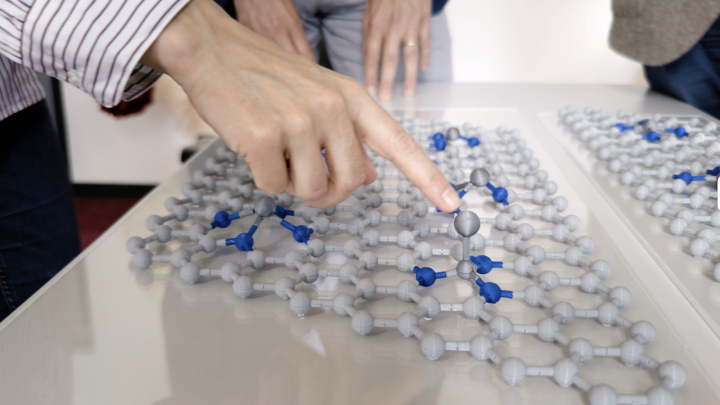
New study reveals hidden diversity in single-atom catalysts
An international collaboration led by NCCR Catalysis groups has demonstrated, for the first time, that not all single atoms in single-atom catalysts are alike. Researchers from ETH Zurich, CRMN Lyon, and Aarhus University applied solid-state platinum NMR spectroscopy to distinguish the distinct local environments of platinum atoms dispersed on various supports.
The study reveals that materials that appear identical by transmission electron microscopy can exhibit a range of coordination environments at the atomic level, with direct implications for their catalytic performance. The researchers further demonstrated how different synthesis protocols and supports influence the nature and evolution of active sites during catalyst evaluation, offering new insights into catalyst stability.
This advance was made possible through close collaboration across institutions and disciplines, combining synthesis, advanced spectroscopy, and theory. The findings mark a major step toward atomic-scale understanding and precision design in heterogeneous catalysis.
In the video, NCCR Catalysis members, including Prof. Javier Pérez-Ramírez, Prof. Christophe Copéret, Dr. Sharon Mitchell, Dr. Alexander Yakimov, Marc-Eduard Usteri (ETH Zurich), and Dr. Jonas Koppe (CRMN Lyon), share their perspectives on this exciting breakthrough in the description of single-atom catalysts.
The study reveals that materials that appear identical by transmission electron microscopy can exhibit a range of coordination environments at the atomic level, with direct implications for their catalytic performance. The researchers further demonstrated how different synthesis protocols and supports influence the nature and evolution of active sites during catalyst evaluation, offering new insights into catalyst stability.
This advance was made possible through close collaboration across institutions and disciplines, combining synthesis, advanced spectroscopy, and theory. The findings mark a major step toward atomic-scale understanding and precision design in heterogeneous catalysis.
In the video, NCCR Catalysis members, including Prof. Javier Pérez-Ramírez, Prof. Christophe Copéret, Dr. Sharon Mitchell, Dr. Alexander Yakimov, Marc-Eduard Usteri (ETH Zurich), and Dr. Jonas Koppe (CRMN Lyon), share their perspectives on this exciting breakthrough in the description of single-atom catalysts.
22.1.2025

2025 IUPAC-Zhejiang NHU International Award for Prof. Javier Pérez-Ramírez
The IUPAC-Zhejiang NHU International Award for Advancements in Green Chemistry, presented biannually at the IUPAC World Chemistry Congress (WCC), honors one established and three early-career scientists in the chemical sciences for their efforts in advancing green chemistry. Prof. Pérez-Ramírez’s recognition centers on his groundbreaking contributions to transforming the landscape of sustainable chemical and energy production. His achievements include the design of a novel catalyst for green methanol synthesis now piloted in industry, the introduction of novel catalysts for CO2 conversion to long-chain hydrocarbons, and pioneering concepts for decentralized ammonia production.
Many of these breakthroughs were achieved within the collaborative framework of NCCR Catalysis, which has also advanced the adoption of digital tools to accelerate catalyst discovery. By integrating sustainability metrics and life-cycle assessments into chemical process design, his work exemplifies the perfect synergy between cutting-edge innovation and environmental responsibility. Congratulations on this well-deserved recognition of your innovative and sustainability-guided contributions to the field, Javier!
Javier will receive the award and deliver a lecture at the 50WCC in Kuala Lumpur, Malaysia, in July 2025.
Many of these breakthroughs were achieved within the collaborative framework of NCCR Catalysis, which has also advanced the adoption of digital tools to accelerate catalyst discovery. By integrating sustainability metrics and life-cycle assessments into chemical process design, his work exemplifies the perfect synergy between cutting-edge innovation and environmental responsibility. Congratulations on this well-deserved recognition of your innovative and sustainability-guided contributions to the field, Javier!
Javier will receive the award and deliver a lecture at the 50WCC in Kuala Lumpur, Malaysia, in July 2025.
1.10.2024

Behind The Publication: Assessing transport phenomena in chemical plastic recycling
Shibashish Jaydev after successfully defending his PhD work at ETH Hönggerberg in September 2024.
In a recent publication, NCCR Catalysis researchers and colleagues highlight the importance of transport phenomena in chemical recycling of polyolefins and derive a metric for catalyst performance evaluation. Learn more about the work from Shibashish Jaydev in this Behind The Publication feature!
Could you tell us about yourself and the way toward this project?
I started at ETH Zurich as a Master’s student in 2018 and then decided to stay for a PhD. I had the pleasure of working on a variety of scientific topics, such as multiphase flows, microfabrication, cytometry and image processing. The common aspect of my student career was that I always wanted to try something new.
At some point, I felt I should come back to my core competence in chemical reaction engineering and approached Prof. Javier Pérez-Ramírez for a PhD position on the topic of chemical recycling of plastics. We decided to tackle polyolefins (polyethylene and polypropylene, comprising around 60% of all plastic waste), using an emerging route called hydrogenolysis, where hydrogen is also a reactant. After initially working on nanoscale catalyst design, we decided to shift our focus to the reactor scale due to the practical nature of the chemical recycling problem. With increasing scale, we realized that the reaction was heat and mass transfer limited, thereby hindering us from realizing the full potential of our catalysts. This led to the conception of this project to assess the influence of transport processes on catalyst effectiveness, which we could pursue thanks to an ETH Grant.
Prof. Javier Pérez-Ramírez, Shibashish Jaydev and Dr. Antonio José Martín Fernández from the aCe group at ETH Hönggerberg in September 2024.
What are the motivation and main results of this project?
In spite of designing and evaluating catalysts that showed great promise, we were convinced to be limited by factors at the reactor scale. The batch reaction we investigated involves three distinct phases, and can only take place when the hydrogen, the catalyst particles and the plastic molecules come together. This means the reaction had to be limited by transport processes, particularly mass transfer, owing to the high viscosity of the plastic melt. An easy way to show this was the changing catalytic performance with the stirring rate. As every research group working in this field uses a different setup, a different stirrer, there was no real way of assessing the extent to which external factors impacted the intrinsic catalyst performance. In this work, we present a means by which this can be done rather easily, independent of the setup or the catalysts.
Which was the main challenge? How did you address it?
Transport processes within a batch reactor system in plastic recycling could be influenced by a multitude of factors - viscosity, stirring speed, vessel dimensions, density and the extent of interfacial contact between the phases. The biggest challenge was to combine these factors into a single equation and present it in an accessible manner for other researchers. We addressed this by looking into possible dimensionless numbers that could help us account for all the factors at once. We thus arrived at a reinterpretation of the well-known power number, something other practitioners could also employ in their own research.
Shibashish Jaydev next to the parallel pressure reactor setup used in the study.
What impact did the ETH Grant have on this work?
As the ETH grant is awarded to high-risk, high-reward projects, the chemical recycling project was a perfect candidate. It provided us with the financial freedom to take risks in terms of exploring and pursuing radically innovative ideas in the initial phases of the project. We were able to expand the scope of our research in catalyst design and explore this reaction thanks to the support provided by the ETH grant.The solid foundation we could lay down owing to the ETH grant culminated in this project which, as a precursor, required access to superior catalysts, a sophisticated setup and other state-of-the-art technologies made possible through the grant.
What is your view on the integration of chemical recycling of plastics in Phase II of NCCR Catalysis?
The project, after its successful run so far, is now at a juncture where it requires multi-domain expertise and collaboration. It has now matured enough to need the involvement of more than one research group - material scientists to study rheology, chemists for operando studies, process and systems engineers for techno-economic studies and also social scientists for macro-level study of the plastic waste problem. I believe NCCR Catalysis offers this collaborative platform to exchange ideas and effectively tackle this multifaceted challenge. Besides, the platform also offers greater visibility to this research topic, inviting broader interests.
Polyolefins - among them polypropylene, which can be made into bottle caps - account for 60% of all plastic waste. © Shibashish Jaydev
What are your future, post-graduation plans?
Right after my PhD, I will start as an R&D Engineer in the chemical process development industry. Since my core interest lies in chemical engineering, I wish to continue working on the design of processes and reactors. I will, however, look to expand my knowledge in the direction of life cycle assessments and economic aspects of chemical processes. A long-term priority for me would be to maintain a solid work-life balance with a lot of sports and spending more time in the mountains.
Publication details:
Assessment of transport phenomena in catalyst effectiveness for chemical polyolefin recycling. S.D. Jaydev, A.J. Martín, D. Garcia, K. Chikri, J. Pérez-Ramírez. Nat. Chem. Eng. 2024, 1, 565. DOI: 10.1038/s44286-024-00108-3.
In a recent publication, NCCR Catalysis researchers and colleagues highlight the importance of transport phenomena in chemical recycling of polyolefins and derive a metric for catalyst performance evaluation. Learn more about the work from Shibashish Jaydev in this Behind The Publication feature!
Could you tell us about yourself and the way toward this project?
I started at ETH Zurich as a Master’s student in 2018 and then decided to stay for a PhD. I had the pleasure of working on a variety of scientific topics, such as multiphase flows, microfabrication, cytometry and image processing. The common aspect of my student career was that I always wanted to try something new.
At some point, I felt I should come back to my core competence in chemical reaction engineering and approached Prof. Javier Pérez-Ramírez for a PhD position on the topic of chemical recycling of plastics. We decided to tackle polyolefins (polyethylene and polypropylene, comprising around 60% of all plastic waste), using an emerging route called hydrogenolysis, where hydrogen is also a reactant. After initially working on nanoscale catalyst design, we decided to shift our focus to the reactor scale due to the practical nature of the chemical recycling problem. With increasing scale, we realized that the reaction was heat and mass transfer limited, thereby hindering us from realizing the full potential of our catalysts. This led to the conception of this project to assess the influence of transport processes on catalyst effectiveness, which we could pursue thanks to an ETH Grant.
Prof. Javier Pérez-Ramírez, Shibashish Jaydev and Dr. Antonio José Martín Fernández from the aCe group at ETH Hönggerberg in September 2024.
What are the motivation and main results of this project?
In spite of designing and evaluating catalysts that showed great promise, we were convinced to be limited by factors at the reactor scale. The batch reaction we investigated involves three distinct phases, and can only take place when the hydrogen, the catalyst particles and the plastic molecules come together. This means the reaction had to be limited by transport processes, particularly mass transfer, owing to the high viscosity of the plastic melt. An easy way to show this was the changing catalytic performance with the stirring rate. As every research group working in this field uses a different setup, a different stirrer, there was no real way of assessing the extent to which external factors impacted the intrinsic catalyst performance. In this work, we present a means by which this can be done rather easily, independent of the setup or the catalysts.
Which was the main challenge? How did you address it?
Transport processes within a batch reactor system in plastic recycling could be influenced by a multitude of factors - viscosity, stirring speed, vessel dimensions, density and the extent of interfacial contact between the phases. The biggest challenge was to combine these factors into a single equation and present it in an accessible manner for other researchers. We addressed this by looking into possible dimensionless numbers that could help us account for all the factors at once. We thus arrived at a reinterpretation of the well-known power number, something other practitioners could also employ in their own research.
Shibashish Jaydev next to the parallel pressure reactor setup used in the study.
What impact did the ETH Grant have on this work?
As the ETH grant is awarded to high-risk, high-reward projects, the chemical recycling project was a perfect candidate. It provided us with the financial freedom to take risks in terms of exploring and pursuing radically innovative ideas in the initial phases of the project. We were able to expand the scope of our research in catalyst design and explore this reaction thanks to the support provided by the ETH grant.The solid foundation we could lay down owing to the ETH grant culminated in this project which, as a precursor, required access to superior catalysts, a sophisticated setup and other state-of-the-art technologies made possible through the grant.
What is your view on the integration of chemical recycling of plastics in Phase II of NCCR Catalysis?
The project, after its successful run so far, is now at a juncture where it requires multi-domain expertise and collaboration. It has now matured enough to need the involvement of more than one research group - material scientists to study rheology, chemists for operando studies, process and systems engineers for techno-economic studies and also social scientists for macro-level study of the plastic waste problem. I believe NCCR Catalysis offers this collaborative platform to exchange ideas and effectively tackle this multifaceted challenge. Besides, the platform also offers greater visibility to this research topic, inviting broader interests.
Polyolefins - among them polypropylene, which can be made into bottle caps - account for 60% of all plastic waste. © Shibashish Jaydev
What are your future, post-graduation plans?
Right after my PhD, I will start as an R&D Engineer in the chemical process development industry. Since my core interest lies in chemical engineering, I wish to continue working on the design of processes and reactors. I will, however, look to expand my knowledge in the direction of life cycle assessments and economic aspects of chemical processes. A long-term priority for me would be to maintain a solid work-life balance with a lot of sports and spending more time in the mountains.
Publication details:
Assessment of transport phenomena in catalyst effectiveness for chemical polyolefin recycling. S.D. Jaydev, A.J. Martín, D. Garcia, K. Chikri, J. Pérez-Ramírez. Nat. Chem. Eng. 2024, 1, 565. DOI: 10.1038/s44286-024-00108-3.
11.9.2024

Official launch of Phase II
On 11 September 2024, we officially launched our program's second funding phase (2024-2028) at Welle7 in Bern with our PIs and group delegates! The meeting served to initiate discussions on our grand research and structure-related challenges and to strengthen collaborations.
We started with input on and insights into program operations and gender balance, plans for higher educational programs, and our network-wide data strategy.
We then enjoyed interactive sessions prepared by our WP Coordinators and colleagues on the standardization of methodologies, strategies for bridging activities in renewable platforms and complex molecules, long-term stability challenges and opportunities in catalysis, and ways to leverage data within our program. We wrapped the meeting up with perspectives on the definition and integration of sustainability and plans for strategic partnerships and the upcoming months.
We started with input on and insights into program operations and gender balance, plans for higher educational programs, and our network-wide data strategy.
We then enjoyed interactive sessions prepared by our WP Coordinators and colleagues on the standardization of methodologies, strategies for bridging activities in renewable platforms and complex molecules, long-term stability challenges and opportunities in catalysis, and ways to leverage data within our program. We wrapped the meeting up with perspectives on the definition and integration of sustainability and plans for strategic partnerships and the upcoming months.
3.9.2024

Strengthening Swiss-Singaporean exchanges on sustainable chemistry research
Group photo of the ETH Zurich-NUS CHI meeting participants taken at NUS on 3 September 2024.
In a recent visit to the National University of Singapore (NUS), delegates from ETH Zurich met with members of the Centre for Hydrogen Innovations (CHI) for a symposium on Replacing Fuels by Chemistry. The symposium was held to strengthen Swiss-Singaporean exchanges in this area, in particular between NCCR Catalysis and NUS-CHI.
Panel discussion at the NUS CHI-ETH Zurich symposium with ETH Zurich professors Victor Mougel, Christophe Copéret, Javier Pérez-Ramírez, Gonzalo Guillén-Gosálbez and Christoph Müller.
The ETH Zurich delegation included NCCR Catalysis members Prof. Javier Pérez-Ramírez (Program Director), Dr. Sharon Mitchell (Program Advisor), Prof. Christophe Copéret (co-coordinator of WP3 Advanced tools), Prof. Gonzalo Guillén-Gosálbez (co-coordinator of WP5 Sustainability), and Prof. Christoph Müller (Principal Investigator), and Prof. Victor Mougel.
Prof. Javier Pérez-Ramírez with NUS hosts professors Dan Zhao (CHI), Ning Yan (CHI Program Director) and Jason Yeo.
As Program Directors of CHI and NCCR Catalysis, respectively, Prof. Ning Yan and Prof. Javier Peréz-Ramírez gave welcoming addresses to kick off the meeting.
The ETH Zurich delegation contributed talks on:
Prof. Javier Pérez-Ramírez: Catalysis and Sustainability: A Journey from Atom to Planet
Prof. Christophe Copéret: Preparation and Characterisation of Heterogeneous Catalysts, One Atom at a Time
Prof. Gonzalo Guillén-Gosálbez: Sustainability Metrics for Chemicals Within Planetary Boundaries
Prof. Christoph Müller: CO2 Capture and Thermocatalytic CO2 Conversion: Model Materials and Their Characterisation
Prof. Victor Mougel: Bio-Inspired Strategies for the Design of Electrocatalysts for Small Molecule Activation
They also contributed to a panel discussion on the role of science, education and policy in decarbonizing the chemical industry.
In addition to the symposium, the visit also included sightseeing and meeting with NUS students, and exchanges with the Singapore-ETH Centre. We thank the delegation’s hosts for their warm welcome and look forward to further fruitful exchanges!
Members of the ETH Zurich delegation with their hosts, visiting the Gardens by the Bay with NUS students and the National Orchid Garden Singapore Botanic Gardens.
In a recent visit to the National University of Singapore (NUS), delegates from ETH Zurich met with members of the Centre for Hydrogen Innovations (CHI) for a symposium on Replacing Fuels by Chemistry. The symposium was held to strengthen Swiss-Singaporean exchanges in this area, in particular between NCCR Catalysis and NUS-CHI.
Panel discussion at the NUS CHI-ETH Zurich symposium with ETH Zurich professors Victor Mougel, Christophe Copéret, Javier Pérez-Ramírez, Gonzalo Guillén-Gosálbez and Christoph Müller.
The ETH Zurich delegation included NCCR Catalysis members Prof. Javier Pérez-Ramírez (Program Director), Dr. Sharon Mitchell (Program Advisor), Prof. Christophe Copéret (co-coordinator of WP3 Advanced tools), Prof. Gonzalo Guillén-Gosálbez (co-coordinator of WP5 Sustainability), and Prof. Christoph Müller (Principal Investigator), and Prof. Victor Mougel.
Prof. Javier Pérez-Ramírez with NUS hosts professors Dan Zhao (CHI), Ning Yan (CHI Program Director) and Jason Yeo.
As Program Directors of CHI and NCCR Catalysis, respectively, Prof. Ning Yan and Prof. Javier Peréz-Ramírez gave welcoming addresses to kick off the meeting.
The ETH Zurich delegation contributed talks on:
Prof. Javier Pérez-Ramírez: Catalysis and Sustainability: A Journey from Atom to Planet
Prof. Christophe Copéret: Preparation and Characterisation of Heterogeneous Catalysts, One Atom at a Time
Prof. Gonzalo Guillén-Gosálbez: Sustainability Metrics for Chemicals Within Planetary Boundaries
Prof. Christoph Müller: CO2 Capture and Thermocatalytic CO2 Conversion: Model Materials and Their Characterisation
Prof. Victor Mougel: Bio-Inspired Strategies for the Design of Electrocatalysts for Small Molecule Activation
They also contributed to a panel discussion on the role of science, education and policy in decarbonizing the chemical industry.
In addition to the symposium, the visit also included sightseeing and meeting with NUS students, and exchanges with the Singapore-ETH Centre. We thank the delegation’s hosts for their warm welcome and look forward to further fruitful exchanges!
Members of the ETH Zurich delegation with their hosts, visiting the Gardens by the Bay with NUS students and the National Orchid Garden Singapore Botanic Gardens.
16.7.2024

Recipients of 2024 Young Talents Fellowship
We’re excited to announce the four recipients of our 2024 Young Talents Fellowship, who will begin their Master’s theses within our member groups in 2024 and 2025. Congratulations and welcome to our network, Aline, Shaipranesh, Nadiia, and Julia!
Aline Hartgers, from Belgium, studies Mathematical Engineering at KU Leuven, and will join Prof. Kjell Jorner’s group at ETH Zürich.
Shaipranesh Senthilkumar, from India, studies Computer Science & Chemistry at BITS Pilani and will join Prof. Philippe Schwaller’s group at EPFL.
Nadiia Vorontsova, from Ukraine, studies Chemistry at the University of Geneva, where she will join Prof. Ross Milton's group.
Julia Ravagnani, from Italy and France, studies Sustainable Chemical Engineering at EPFL and will join Prof. Gonzalo Guillén-Gosálbez's group at ETH Zurich.
The Young Talents Fellowship supports students with exceptional academic records and diverse backgrounds. It provides them with the opportunity to conduct a Master’s thesis project in a research group associated with NCCR Catalysis and establish their connections and ideas in a multidisciplinary, cross-fertilizing environment of research excellence. This initiative to promote fair representation in catalysis research was launched in 2022.
Aline Hartgers, from Belgium, studies Mathematical Engineering at KU Leuven, and will join Prof. Kjell Jorner’s group at ETH Zürich.
Shaipranesh Senthilkumar, from India, studies Computer Science & Chemistry at BITS Pilani and will join Prof. Philippe Schwaller’s group at EPFL.
Nadiia Vorontsova, from Ukraine, studies Chemistry at the University of Geneva, where she will join Prof. Ross Milton's group.
Julia Ravagnani, from Italy and France, studies Sustainable Chemical Engineering at EPFL and will join Prof. Gonzalo Guillén-Gosálbez's group at ETH Zurich.
The Young Talents Fellowship supports students with exceptional academic records and diverse backgrounds. It provides them with the opportunity to conduct a Master’s thesis project in a research group associated with NCCR Catalysis and establish their connections and ideas in a multidisciplinary, cross-fertilizing environment of research excellence. This initiative to promote fair representation in catalysis research was launched in 2022.
27.6.2024
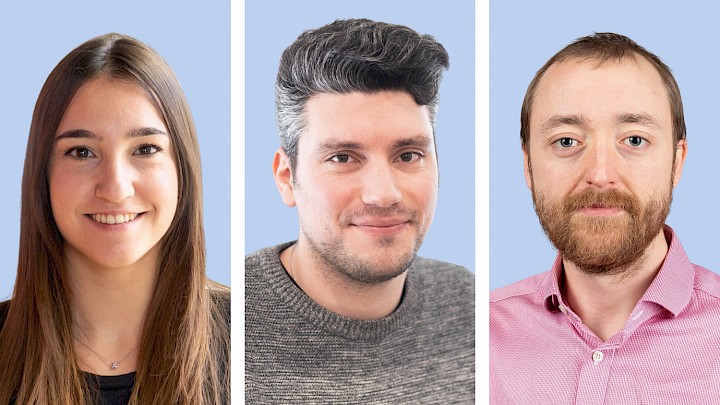
From Spain to Switzerland: a lab exchange between computational and experimental researchers
Team portrait, from left to right: Andrea Ruiz-Ferrando, Dr. Javier Heras-Domingo, and Dr. Adam Clark.In March, two researchers from ICIQ in Spain came to PSI and ETH Zurich, Switzerland for a one-week lab exchange supported through the NCCR Catalysis Catalyzer Program. Meet Andrea Ruiz-Ferrando and Dr. Javier Heras-Domingo, who share their impressions from their exchange hosted by Dr. Adam Clark, and their experiences on bridging the gap between experimental and computational groups!
Hi Andrea and Javi, could you tell us about yourselves and your research within NCCR Catalysis?Andrea: I hold a degree in chemistry and have been a PhD student in the group of Prof. Núria López at ICIQ since 2020. My research is centered on the fascinating realm of single-atom catalysts within the domain of theoretical chemistry. Specifically, I delve into finding experimentally guided synthesis-structure-property relationships inherent to these catalytic systems. What makes my work particularly exciting is the interdisciplinary nature of my approach: I collaborate with experimentalists, bridging the gap between theory and practice. I enjoy engaging in social activities, whether it’s exploring new places or meeting new people, and the lab exchange was a great opportunity for this.Javi: Originally from Barcelona, I completed my PhD in Computational Chemistry at the Universitat Autònoma de Barcelona. My academic journey then took me to the United States, where I spent three enriching years at Carnegie Mellon University for my first postdoctoral researcher position. During this time, I collaborated with Facebook AI to dive into data science and deep learning approaches applied to chemistry and, in particular, to heterogeneous catalysis. Nowadays, I’m a postdoctoral researcher in Prof. Núria López’s research group, focusing on pushing the boundaries of characterization techniques leveraging the power of artificial intelligence (AI), with the aim to extract more quantitative data that will help to design better catalysts with tailored properties.Javi, Andrea and Adam in front of PSI’s Swiss Light Source facilities (left), and Javi and Adam discussing their project (right).How did the collaboration between the López, Pérez-Ramírez groups and Dr. Adam Clark emerge, and what insights have you gained from this collaboration?Javi: The smart characterization research line originated from a collaborative effort between Prof. Núria López’s group at ICIQ, Prof. Javier Pérez-Ramírez at ETH Zurich, and the Barcelona Supercomputing Center (BSC), implementing a deep learning model to detect single-atom catalysts via electron microscopy back in the pandemic. Our current project, a collaboration between ICIQ, ETH, and PSI, aims to enhance catalyst design through advanced characterization strategies, leveraging automated data generation and AI in synchrotron-based techniques like XANES (X-ray Absorption Near Edge Structure) and EXAFS (Extended X-ray Absorption Fine Structure). This approach promises advancements in catalysis, with far-reaching socio-economic impacts.You recently did a one-week lab exchange at PSI and ETH Zurich, Switzerland. How has this exchange benefited you as researchers and the project?Javi: The Catalyzer Program we recently participated in has proven to be an invaluable asset for advancing our current research project. During an intensive one-week laboratory exchange, we gained profound insights into the intricacies of extracting data from EXAFS spectra. This hands-on experience has significantly enriched our understanding, placing us in a much stronger position to incorporate AI into enhancing this technique. The knowledge and techniques acquired through this program have not only bolstered our research capabilities but also opened new avenues for innovation in applying AI to improve data analysis and extraction methods in our field.Andrea, Adam, and Javi having dinner with Dr. Olga Safonova, NCCR Catalysis Principal Investigator at PSI (left), and Javi and Andrea meeting with Vera Giulimondi and Dr. Sharon Mitchell from the group of NCCR Catalysis Director Prof. Javier Pérez-Ramírez at ETH Zurich (right).What advice would you give other early-career researchers on collaborations and exchanges between labs?Andrea: Forge fruitful collaborations by actively seeking shared interests and laying the foundation with ontologies - the common language that ensures effective communication. Embrace diverse perspectives to collaboratively define the project's scope and determine the correct methodology for seamless progress. Be adaptable to changes and uncertainties, cultivating a collaborative mindset that views differences as opportunities for collective growth. Ensure the adoption of an integrative approach right from the outset, emphasizing a cooperative evolution of the project. This proactive stand prevents potential misconceptions and exploits synergistic relationships across research groups.What will be the next steps in your collaboration?Andrea & Javi: The next phase of our collaboration is set to significantly enhance our AI method by integrating experimental data. This pivotal step will not only broaden the method’s applicability but also ensure its robustness in predicting outcomes in experimental environments. Such a move is essential, as relying solely on theoretical data limits our understanding and the potential for real-world applications. Incorporating experimental insights will equip our AI approach with a much-needed depth, making it a more general and powerful tool for navigating the complexities of experimental conditions.Thank you so much for sharing your experience! We wish you and your colleagues the very best for your project.
Learn more about Andrea’s research here and here, and connect with her on Twitter/X and LinkedIn. Learn more about Javier’s research here and here, and connect with him on Twitter/X and LinkedIn.
Hi Andrea and Javi, could you tell us about yourselves and your research within NCCR Catalysis?Andrea: I hold a degree in chemistry and have been a PhD student in the group of Prof. Núria López at ICIQ since 2020. My research is centered on the fascinating realm of single-atom catalysts within the domain of theoretical chemistry. Specifically, I delve into finding experimentally guided synthesis-structure-property relationships inherent to these catalytic systems. What makes my work particularly exciting is the interdisciplinary nature of my approach: I collaborate with experimentalists, bridging the gap between theory and practice. I enjoy engaging in social activities, whether it’s exploring new places or meeting new people, and the lab exchange was a great opportunity for this.Javi: Originally from Barcelona, I completed my PhD in Computational Chemistry at the Universitat Autònoma de Barcelona. My academic journey then took me to the United States, where I spent three enriching years at Carnegie Mellon University for my first postdoctoral researcher position. During this time, I collaborated with Facebook AI to dive into data science and deep learning approaches applied to chemistry and, in particular, to heterogeneous catalysis. Nowadays, I’m a postdoctoral researcher in Prof. Núria López’s research group, focusing on pushing the boundaries of characterization techniques leveraging the power of artificial intelligence (AI), with the aim to extract more quantitative data that will help to design better catalysts with tailored properties.Javi, Andrea and Adam in front of PSI’s Swiss Light Source facilities (left), and Javi and Adam discussing their project (right).How did the collaboration between the López, Pérez-Ramírez groups and Dr. Adam Clark emerge, and what insights have you gained from this collaboration?Javi: The smart characterization research line originated from a collaborative effort between Prof. Núria López’s group at ICIQ, Prof. Javier Pérez-Ramírez at ETH Zurich, and the Barcelona Supercomputing Center (BSC), implementing a deep learning model to detect single-atom catalysts via electron microscopy back in the pandemic. Our current project, a collaboration between ICIQ, ETH, and PSI, aims to enhance catalyst design through advanced characterization strategies, leveraging automated data generation and AI in synchrotron-based techniques like XANES (X-ray Absorption Near Edge Structure) and EXAFS (Extended X-ray Absorption Fine Structure). This approach promises advancements in catalysis, with far-reaching socio-economic impacts.You recently did a one-week lab exchange at PSI and ETH Zurich, Switzerland. How has this exchange benefited you as researchers and the project?Javi: The Catalyzer Program we recently participated in has proven to be an invaluable asset for advancing our current research project. During an intensive one-week laboratory exchange, we gained profound insights into the intricacies of extracting data from EXAFS spectra. This hands-on experience has significantly enriched our understanding, placing us in a much stronger position to incorporate AI into enhancing this technique. The knowledge and techniques acquired through this program have not only bolstered our research capabilities but also opened new avenues for innovation in applying AI to improve data analysis and extraction methods in our field.Andrea, Adam, and Javi having dinner with Dr. Olga Safonova, NCCR Catalysis Principal Investigator at PSI (left), and Javi and Andrea meeting with Vera Giulimondi and Dr. Sharon Mitchell from the group of NCCR Catalysis Director Prof. Javier Pérez-Ramírez at ETH Zurich (right).What advice would you give other early-career researchers on collaborations and exchanges between labs?Andrea: Forge fruitful collaborations by actively seeking shared interests and laying the foundation with ontologies - the common language that ensures effective communication. Embrace diverse perspectives to collaboratively define the project's scope and determine the correct methodology for seamless progress. Be adaptable to changes and uncertainties, cultivating a collaborative mindset that views differences as opportunities for collective growth. Ensure the adoption of an integrative approach right from the outset, emphasizing a cooperative evolution of the project. This proactive stand prevents potential misconceptions and exploits synergistic relationships across research groups.What will be the next steps in your collaboration?Andrea & Javi: The next phase of our collaboration is set to significantly enhance our AI method by integrating experimental data. This pivotal step will not only broaden the method’s applicability but also ensure its robustness in predicting outcomes in experimental environments. Such a move is essential, as relying solely on theoretical data limits our understanding and the potential for real-world applications. Incorporating experimental insights will equip our AI approach with a much-needed depth, making it a more general and powerful tool for navigating the complexities of experimental conditions.Thank you so much for sharing your experience! We wish you and your colleagues the very best for your project.
Learn more about Andrea’s research here and here, and connect with her on Twitter/X and LinkedIn. Learn more about Javier’s research here and here, and connect with him on Twitter/X and LinkedIn.
16.5.2024

NCCR Catalysis Trailblazers: Anastasiia Komarova
For our second Trailblazers feature, meet Dr. Anastasiia Komarova (she/her) from EPFL in the group of Prof. Jeremy Luterbacher! She has been working across three continents with the goal of engineering a greener future in chemistry. During her PhD studies, she filed three patents and received several awards.Hi Anastasiia, could you tell us about yourself and your research within NCCR Catalysis?
With pleasure! I am a PhD researcher at Jeremy Luterbacher’s group at EPFL. My research, supported by NCCR Catalysis, focuses on developing a novel class of green solvents from non-edible lignocellulosic biomass. Imagine starting with something as simple as corn cobs in the flask – and then watching the magic of chemistry unfold to create valuable nature-inspired chemical products! Our new solvents offer a renewable alternative to traditional toxic and fossil-derived counterparts. We now see growing interest in our solvents from industry and research institutions as they shift toward more sustainable practices. That’s why we’ve recently scaled up solvent production to a multi-kg scale to ensure everyone can get a sample to try! Outside the lab, you might find me playing the keys in the music band or hitting tennis balls – activities that keep my creative energies flowing!Anastasiia showcasing a novel green solvent made from biomass at EPFL (left) and performing with her band at Fécule Festival in 2023 organized by the University of Lausanne (right).What made you consider a career in science, and what/who got you interested in science in the first place?As a teenager, I enjoyed chemistry, biology, and math classes - though I wasn't the quintessential science geek. When figuring out what to do after high school, I sought advice from my family. Most of them said something like, “Pick anything but what I do for a living”. The only exceptions were my uncle and aunt, both brilliant scientists, who advised me to “go for science like we did! Do chemistry; it’s really cool!”. I've never regretted this choice and am grateful to them for inspiring my career path in science!Where are you from and what is your background?
I was born and raised in Siberia, Russia. After highschool, I enrolled in a prestigious and competitive Chemistry program at Novosibirsk State University in Akademgorodok, a unique place surrounded by Siberian nature and renowned research institutions just outside the bustling city of Novosibirsk. During my studies, I worked with scientists from these institutions to complete both my Bachelor’s and Master’s theses. I was a proactive student and seized every opportunity to gain new experience. This drive first led me to explore the academic world in Europe (Italy), and then in the USA, where I worked for a while as a researcher. Inspired by these international experiences, I decided to pursue a PhD position abroad and ultimately chose EPFL in Switzerland! To me, Lausanne has a somewhat similar vibe to the one I experienced in Akadem: collaborative, friendly, and intellectually vibrant.What value has NCCR Catalysis brought to you as an early-career researcher?
NCCR Catalysis opened the door for me to a unique community of leading experts across various branches of chemistry. This opportunity allowed me to find key collaborators for my doctoral project. Together, we elevated this work to new heights, something I couldn't have achieved on my own. Plus, presenting my research at several NCCR Catalysis Annual Meetings was a fantastic experience. I got a ton of helpful feedback, won the best talk prize once, and made valuable connections in my field.Anastasiia presenting at the NCCR Catalysis Annual Retreat 2022 (left), where she received a best talk prize, awarded by Dr. Sharon Mitchell, Program Advisor, and Prof. Jérôme Waser, Co-Director (right). © NCCR CatalysisDuring your doctoral degree, you had three patents granted. Could you tell us about this experience, and how it enriched your studies?
Patenting your inventions is very exciting! It means that the technology or product you are developing has practical value and might one day hit the market. The patenting process, though, is quite complex and vastly different from writing a research article. Fortunately, I wasn’t alone on this journey. I received a lot of support from our Technology Transfer Office on campus, and I even took a course offered by EPFL to learn more about what patent attorneys usually do. This experience was a valuable part of my doctoral studies and also revealed an interesting alternative career path for researchers in STEM like myself.What advice would you give other female early-career researchers in STEM?
Networking, networking, and once again… networking! Join events, conferences, and mentorship programs where you can connect with industry experts and great scientists. Learn how to effectively communicate your research to people with different backgrounds - you can even practice with your grandparents or younger siblings! Don’t be afraid of changing your research area as you transition from the Bachelor’s to Master’s and then to the PhD level. But always prioritize finding the right advisor and supportive work environment over the specific research project. Above all, be kind to yourself and trust your intuition!Anastasiia presenting her NCCR Catalysis work (left) and receiving the Runner-up Award for Best Oral Presentation in Catalysis Sciences & Engineering from the Swiss Chemical Society at the Fall Meeting 2023, awarded by Markus Steinke, representative of Metrohm (right). © Swiss Chemical SocietyYou recently obtained your doctoral degree - congratulations! What will be your next adventure?
Thank you! Right after passing my PhD defense, I embarked on my next adventure by flying to an island in the middle of the Atlantic Ocean to rest and reflect on what I wanted to do next. After completing PhD, you have so many options! I am flexible and open to all opportunities, from continuing in academia as a postdoc to making a leap to industry jobs in R&D or process development. Additionally, here in Switzerland, there's a plethora of startup companies. Why not consider joining one or even founding a new one? 😊Thank you so much for sharing your experience! We wish you the very best for your next steps.
Learn more about Anastasiia’s research here and connect with her on LinkedIn and Instagram.
With pleasure! I am a PhD researcher at Jeremy Luterbacher’s group at EPFL. My research, supported by NCCR Catalysis, focuses on developing a novel class of green solvents from non-edible lignocellulosic biomass. Imagine starting with something as simple as corn cobs in the flask – and then watching the magic of chemistry unfold to create valuable nature-inspired chemical products! Our new solvents offer a renewable alternative to traditional toxic and fossil-derived counterparts. We now see growing interest in our solvents from industry and research institutions as they shift toward more sustainable practices. That’s why we’ve recently scaled up solvent production to a multi-kg scale to ensure everyone can get a sample to try! Outside the lab, you might find me playing the keys in the music band or hitting tennis balls – activities that keep my creative energies flowing!Anastasiia showcasing a novel green solvent made from biomass at EPFL (left) and performing with her band at Fécule Festival in 2023 organized by the University of Lausanne (right).What made you consider a career in science, and what/who got you interested in science in the first place?As a teenager, I enjoyed chemistry, biology, and math classes - though I wasn't the quintessential science geek. When figuring out what to do after high school, I sought advice from my family. Most of them said something like, “Pick anything but what I do for a living”. The only exceptions were my uncle and aunt, both brilliant scientists, who advised me to “go for science like we did! Do chemistry; it’s really cool!”. I've never regretted this choice and am grateful to them for inspiring my career path in science!Where are you from and what is your background?
I was born and raised in Siberia, Russia. After highschool, I enrolled in a prestigious and competitive Chemistry program at Novosibirsk State University in Akademgorodok, a unique place surrounded by Siberian nature and renowned research institutions just outside the bustling city of Novosibirsk. During my studies, I worked with scientists from these institutions to complete both my Bachelor’s and Master’s theses. I was a proactive student and seized every opportunity to gain new experience. This drive first led me to explore the academic world in Europe (Italy), and then in the USA, where I worked for a while as a researcher. Inspired by these international experiences, I decided to pursue a PhD position abroad and ultimately chose EPFL in Switzerland! To me, Lausanne has a somewhat similar vibe to the one I experienced in Akadem: collaborative, friendly, and intellectually vibrant.What value has NCCR Catalysis brought to you as an early-career researcher?
NCCR Catalysis opened the door for me to a unique community of leading experts across various branches of chemistry. This opportunity allowed me to find key collaborators for my doctoral project. Together, we elevated this work to new heights, something I couldn't have achieved on my own. Plus, presenting my research at several NCCR Catalysis Annual Meetings was a fantastic experience. I got a ton of helpful feedback, won the best talk prize once, and made valuable connections in my field.Anastasiia presenting at the NCCR Catalysis Annual Retreat 2022 (left), where she received a best talk prize, awarded by Dr. Sharon Mitchell, Program Advisor, and Prof. Jérôme Waser, Co-Director (right). © NCCR CatalysisDuring your doctoral degree, you had three patents granted. Could you tell us about this experience, and how it enriched your studies?
Patenting your inventions is very exciting! It means that the technology or product you are developing has practical value and might one day hit the market. The patenting process, though, is quite complex and vastly different from writing a research article. Fortunately, I wasn’t alone on this journey. I received a lot of support from our Technology Transfer Office on campus, and I even took a course offered by EPFL to learn more about what patent attorneys usually do. This experience was a valuable part of my doctoral studies and also revealed an interesting alternative career path for researchers in STEM like myself.What advice would you give other female early-career researchers in STEM?
Networking, networking, and once again… networking! Join events, conferences, and mentorship programs where you can connect with industry experts and great scientists. Learn how to effectively communicate your research to people with different backgrounds - you can even practice with your grandparents or younger siblings! Don’t be afraid of changing your research area as you transition from the Bachelor’s to Master’s and then to the PhD level. But always prioritize finding the right advisor and supportive work environment over the specific research project. Above all, be kind to yourself and trust your intuition!Anastasiia presenting her NCCR Catalysis work (left) and receiving the Runner-up Award for Best Oral Presentation in Catalysis Sciences & Engineering from the Swiss Chemical Society at the Fall Meeting 2023, awarded by Markus Steinke, representative of Metrohm (right). © Swiss Chemical SocietyYou recently obtained your doctoral degree - congratulations! What will be your next adventure?
Thank you! Right after passing my PhD defense, I embarked on my next adventure by flying to an island in the middle of the Atlantic Ocean to rest and reflect on what I wanted to do next. After completing PhD, you have so many options! I am flexible and open to all opportunities, from continuing in academia as a postdoc to making a leap to industry jobs in R&D or process development. Additionally, here in Switzerland, there's a plethora of startup companies. Why not consider joining one or even founding a new one? 😊Thank you so much for sharing your experience! We wish you the very best for your next steps.
Learn more about Anastasiia’s research here and connect with her on LinkedIn and Instagram.
30.4.2024

Behind The Publication: Exploring Cu-promoted ZnZrOx catalysts for CO2 to methanol synthesis
Team portrait, from left to right: Dr. Thaylan Pinheiro Araújo, Dr. Jordi Morales Vidal, Dr. Mikhail Agrachev, and Patrik Willi.
In a recent collaborative publication, a team of experimental and computational experts from four NCCR Catalysis member groups investigated a sustainable class of catalyst promoters and their workings. Learn more about the work from Dr. Thaylan Pinheiro Araújo (aCe lab, ETHZ), Dr. Jordi Morales Vidal (TheorHetCat Group, ICIQ), Dr. Mikhail Agrachev (EPR Research Group, ETHZ), and Patrik Willi (Functional Materials Laboratory, ETHZ) in this Behind The Publication feature!
Can you briefly introduce the concept of your project and your roles?
Thaylan: The production of chemicals places a burden on our planet; our study addresses the sustainable production of methanol, a key building block for the chemical industry, through CO2 valorization. We aimed to systematically investigate the promotion of mixed zinc-zirconium oxides (ZnZrOx), a promising catalyst family for CO2 hydrogenation to methanol. Building upon our past collaborative endeavors within the NCCR Catalysis framework, multiple groups with distinct expertise joined forces to tackle this challenge. Among diverse hydrogenation metals examined, we - surprisingly! - identified copper as the most effective promoter, exceeding even palladium, and provided atomic-level rationalization of the working state of the new Cu-promoted ZnZrOx catalyst. Our findings show the potential for an earth-abundant, more sustainable promoter class.
My primary role in this project was to closely collaborate with all team members, facilitating the exchange of insights and ultimately synthesizing their invaluable contributions into the cohesive narrative of our study.
The team used a standardized flame spray pyrolysis approach to prepare ZnZrOx catalysts with small amounts (0.5 mol%) of diverse hydrogenation metals (Re, Co, Au, Ni, Rh, Ag, Ir, Ru, Pt, Pd, and Cu).
How did the collaboration between your groups and disciplines come about?
Thaylan: Catalysis, with its multidisciplinary nature spanning various scales, inherently requires complementary expertise. The collaboration among our groups with diverse know-how - from standardized catalyst synthesis and evaluation to in-depth characterization and theoretical simulations - flowed seamlessly in this study. Indeed, our collaboration felt instinctive, given our successful history of tackling other challenging questions within the NCCR Catalysis since 2021, when we first came together to investigate metal promotion in In2O3-catalyzed methanol synthesis via CO2 hydrogenation.
How did your experience working with characterization and mechanism analysis help advance your understanding of the catalyst?
Mikhail: Our team’s broad expertise in different fields helped us work on these complex catalysts. From the point of view of EPR methodology, the main novelty was to bring concepts from magnetism and solid-state physics together with traditional EPR approaches to get a structural and mechanistic understanding of the catalytic process. Also, performing the measurements in-situ/operando is still uncommon in the field. Of course, close collaboration and exchange of results and ideas between the researchers was essential to achieve our results, as one can hardly answer the big questions in catalysis by applying a single method.
Were there any unexpected challenges during the collaboration, and how did you address them?
Mikhail: The initial challenge was communicating with researchers from different disciplines. My background is in spectroscopic/physical chemistry, and my approach is often very different from that of collaborators, who are chemical engineers and computational chemists. However, as I learned over several years of close and fruitful collaborations, the ability to approach challenges from different perspectives makes it possible to solve problems in sustainable chemistry. Thanks to these collaborations and changes in perspective, we made relevant scientific contributions, and I became more open-minded, both scientifically and personally.
What message or insight do you hope readers take away from your collaborative work?
Patrik: This collaboration demonstrates the potency of interdisciplinary work in tackling current challenges in catalysis and sustainable chemistry. Scientifically, each contribution – from state-of-the-art characterization to modeling and preparation – was indispensable for obtaining and understanding these novel catalysts. The shared goals and clear communication throughout the project were vital to its success. Personally, our joint endeavor forged lasting bonds across the research groups, and we hope our example encourages others to unlock the full potential of collaborative work.
Visualization of Cu0 species forming Zn-rich low-nuclearity CuZn clusters on the ZrO2 surface during the reaction, which correlates with the generation of oxygen vacancies in their vicinity.
Where do you see the intersection of catalyst development, computational chemistry and mechanism elucidation research heading in the field of heterogeneous catalysis?
Jordi: The intersection between experiments and modeling is crucial for the efficient design of novel materials and processes. The synergy between these two fields leverages their strengths and is greater than the sum of their parts. In our work, the in-depth experimental characterization was pivotal for building representative models of the Cu-ZnZrOx system for density functional theory simulations. We used these models to provide insights at the atomic level to reveal synthesis-structure-performance relationships. This approach paves the way for performing high-throughput screening of catalytic materials coupled with machine learning to accelerate the discovery of relevant catalysts for green methanol production.
What role has NCCR Catalysis played in developing this work?
Thaylan: The program was pivotal in developing this work by fostering collaboration among groups, facilitating larger-scale projects, and providing access to a broad community of researchers in Switzerland and beyond. Our groups could not have accessed the necessary resources and achieved these synergistic efforts individually, and the consortium framework enhanced the scope and impact of our research.
Publication details:
Low-nuclearity CuZn ensembles on ZnZrOx catalyze methanol synthesis from CO2. T. Pinheiro Araújo, G. Giannakakis, J. Morales-Vidal, M. Agrachev, Z. Ruiz-Bernal, P. Preikschas, T. Zou, F. Krumeich, P.O. Willi, W.J. Stark, R.N. Grass, G. Jeschke, S. Mitchell, N. López, J. Pérez-Ramírez. Nat. Commun. 2024, 15, 3101. DOI: 10.1038/s41467-024-47447-6.
In a recent collaborative publication, a team of experimental and computational experts from four NCCR Catalysis member groups investigated a sustainable class of catalyst promoters and their workings. Learn more about the work from Dr. Thaylan Pinheiro Araújo (aCe lab, ETHZ), Dr. Jordi Morales Vidal (TheorHetCat Group, ICIQ), Dr. Mikhail Agrachev (EPR Research Group, ETHZ), and Patrik Willi (Functional Materials Laboratory, ETHZ) in this Behind The Publication feature!
Can you briefly introduce the concept of your project and your roles?
Thaylan: The production of chemicals places a burden on our planet; our study addresses the sustainable production of methanol, a key building block for the chemical industry, through CO2 valorization. We aimed to systematically investigate the promotion of mixed zinc-zirconium oxides (ZnZrOx), a promising catalyst family for CO2 hydrogenation to methanol. Building upon our past collaborative endeavors within the NCCR Catalysis framework, multiple groups with distinct expertise joined forces to tackle this challenge. Among diverse hydrogenation metals examined, we - surprisingly! - identified copper as the most effective promoter, exceeding even palladium, and provided atomic-level rationalization of the working state of the new Cu-promoted ZnZrOx catalyst. Our findings show the potential for an earth-abundant, more sustainable promoter class.
My primary role in this project was to closely collaborate with all team members, facilitating the exchange of insights and ultimately synthesizing their invaluable contributions into the cohesive narrative of our study.
The team used a standardized flame spray pyrolysis approach to prepare ZnZrOx catalysts with small amounts (0.5 mol%) of diverse hydrogenation metals (Re, Co, Au, Ni, Rh, Ag, Ir, Ru, Pt, Pd, and Cu).
How did the collaboration between your groups and disciplines come about?
Thaylan: Catalysis, with its multidisciplinary nature spanning various scales, inherently requires complementary expertise. The collaboration among our groups with diverse know-how - from standardized catalyst synthesis and evaluation to in-depth characterization and theoretical simulations - flowed seamlessly in this study. Indeed, our collaboration felt instinctive, given our successful history of tackling other challenging questions within the NCCR Catalysis since 2021, when we first came together to investigate metal promotion in In2O3-catalyzed methanol synthesis via CO2 hydrogenation.
How did your experience working with characterization and mechanism analysis help advance your understanding of the catalyst?
Mikhail: Our team’s broad expertise in different fields helped us work on these complex catalysts. From the point of view of EPR methodology, the main novelty was to bring concepts from magnetism and solid-state physics together with traditional EPR approaches to get a structural and mechanistic understanding of the catalytic process. Also, performing the measurements in-situ/operando is still uncommon in the field. Of course, close collaboration and exchange of results and ideas between the researchers was essential to achieve our results, as one can hardly answer the big questions in catalysis by applying a single method.
Were there any unexpected challenges during the collaboration, and how did you address them?
Mikhail: The initial challenge was communicating with researchers from different disciplines. My background is in spectroscopic/physical chemistry, and my approach is often very different from that of collaborators, who are chemical engineers and computational chemists. However, as I learned over several years of close and fruitful collaborations, the ability to approach challenges from different perspectives makes it possible to solve problems in sustainable chemistry. Thanks to these collaborations and changes in perspective, we made relevant scientific contributions, and I became more open-minded, both scientifically and personally.
What message or insight do you hope readers take away from your collaborative work?
Patrik: This collaboration demonstrates the potency of interdisciplinary work in tackling current challenges in catalysis and sustainable chemistry. Scientifically, each contribution – from state-of-the-art characterization to modeling and preparation – was indispensable for obtaining and understanding these novel catalysts. The shared goals and clear communication throughout the project were vital to its success. Personally, our joint endeavor forged lasting bonds across the research groups, and we hope our example encourages others to unlock the full potential of collaborative work.
Visualization of Cu0 species forming Zn-rich low-nuclearity CuZn clusters on the ZrO2 surface during the reaction, which correlates with the generation of oxygen vacancies in their vicinity.
Where do you see the intersection of catalyst development, computational chemistry and mechanism elucidation research heading in the field of heterogeneous catalysis?
Jordi: The intersection between experiments and modeling is crucial for the efficient design of novel materials and processes. The synergy between these two fields leverages their strengths and is greater than the sum of their parts. In our work, the in-depth experimental characterization was pivotal for building representative models of the Cu-ZnZrOx system for density functional theory simulations. We used these models to provide insights at the atomic level to reveal synthesis-structure-performance relationships. This approach paves the way for performing high-throughput screening of catalytic materials coupled with machine learning to accelerate the discovery of relevant catalysts for green methanol production.
What role has NCCR Catalysis played in developing this work?
Thaylan: The program was pivotal in developing this work by fostering collaboration among groups, facilitating larger-scale projects, and providing access to a broad community of researchers in Switzerland and beyond. Our groups could not have accessed the necessary resources and achieved these synergistic efforts individually, and the consortium framework enhanced the scope and impact of our research.
Publication details:
Low-nuclearity CuZn ensembles on ZnZrOx catalyze methanol synthesis from CO2. T. Pinheiro Araújo, G. Giannakakis, J. Morales-Vidal, M. Agrachev, Z. Ruiz-Bernal, P. Preikschas, T. Zou, F. Krumeich, P.O. Willi, W.J. Stark, R.N. Grass, G. Jeschke, S. Mitchell, N. López, J. Pérez-Ramírez. Nat. Commun. 2024, 15, 3101. DOI: 10.1038/s41467-024-47447-6.
11.4.2024

Phase II Continuation Party in Bern
In Spring 2024, we gathered our amazing community and supporters to celebrate our program's continuation to its second funding phase (2024-2028) and our many achievements in sustainable chemistry and beyond during the past four years!
We had a lovely evening at Zentrum Paul Klee in Bern, where we had a short toast, food and drinks, lots of cake, and karaoke.
We're grateful for the continued support of the Swiss National Science Foundation, ETH Zurich, and EPFL, and we thank our Review Panel for continuing to challenge us to be at the forefront of sustainable chemistry.
We had a lovely evening at Zentrum Paul Klee in Bern, where we had a short toast, food and drinks, lots of cake, and karaoke.
We're grateful for the continued support of the Swiss National Science Foundation, ETH Zurich, and EPFL, and we thank our Review Panel for continuing to challenge us to be at the forefront of sustainable chemistry.
8.3.2024

NCCR Catalysis Trailblazers: Alessandra Toniato
We’re kicking off the NCCR Catalysis Trailblazers series on exceptional individuals breaking barriers and making waves in research! On International Women's Day, meet Alessandra Toniato (she/her), a PhD researcher at IBM Research in Dr. Teodoro Laino’s team. In her ~3.5 years of doctoral research, she contributed to over seven publications and became a mother twice.Hi Alessandra, could you tell us about yourself and your research within NCCR Catalysis?
Sure! There is only one thing I like to discuss more than my work - my kids! In the context of NCCR Catalysis, I am a PhD researcher leveraging AI to solve complex chemical problems. In particular, I have been working extensively on data curation and retrosynthesis, the crucial task of inferring the building blocks needed to obtain a target compound.
Alessandra at the NCCR Catalysis Annual Event 2022 (left) and Y3 Annual Review Meeting 2023 (right). © NCCR CatalysisWhat made you consider a career in science, and who got you interested in science in the first place?
When we make our choices, we are all influenced by our heroes. I have always had a strong bond with my parents. While my mother taught me how important it is for a woman to work, my dad got me into science. He is a mechanical engineer, and I have always dreamed of becoming like him. “L’uomo buono desidera conoscere” (The good man desires to know) he frequently says. Instead of buying a new dishwasher, he tries to fix the old one just to determine which was the problem.During your doctoral studies, you became a mother twice. How have you balanced work and family duties, and how did your environment support you?
It was not trivial. The balance between work and family is not stable. There are periods in which it is easier and others in which you need to hand in a project while your child is sick. In these moments, the support of my husband was and is crucial: we split the fatigue. On top of that, my manager was always sensitive to the situation: I never had to stick to fixed working hours or on-site work. Taking the kids to the doctor was never a problem.
When I became a mum, I knew that sending my children to the Kita (daycare center) was an investment for their social development and my career. Still, the Kita cost in Switzerland for two kids is more than my net salary. Thanks to the NCCR Flexibility Grant, I was able to alleviate that cost.
It is absurd how little support families (women) receive in the most challenging years of parenthood.
What advice would you give other female early-stage researchers regarding parenthood?
First, don’t wait for the perfect moment to have a family. If you desire it, just do it. Once you are in, you will find time for everything. And second, be clear about your priorities. Of course, you will not be able to work overtime, but this does not mean you cannot do your job. You will always feel as if you are not working enough or spending enough time with your kids: that’s normal; it’s part of the game.
But remember, no perfect mum or situation exists.
Alessandra and colleagues of the RXN for Chemistry Project Team received the 2022 Sandmeyer Award from the Swiss Chemical Society at the Swiss Chemistry Science Night 2022. © Swiss Chemical SocietyYou recently obtained your doctoral degree - congratulations! What will be your next adventure?
Thank you! I still haven’t realized it yet! I am open to different opportunities, possibly still in the technical field of Artificial Intelligence. My only condition for my future job is flexibility: I love to be a mum and spend time with my kids, and I will not renounce this. I believe the world is slowly understanding that it is not important how many hours you stay in the office, but how you work.Thank you so much for sharing your experience! We wish you the very best for your next steps.
Learn more about Alessandra’s research here and connect with her on Twitter/X and LinkedIn.
Sure! There is only one thing I like to discuss more than my work - my kids! In the context of NCCR Catalysis, I am a PhD researcher leveraging AI to solve complex chemical problems. In particular, I have been working extensively on data curation and retrosynthesis, the crucial task of inferring the building blocks needed to obtain a target compound.
Alessandra at the NCCR Catalysis Annual Event 2022 (left) and Y3 Annual Review Meeting 2023 (right). © NCCR CatalysisWhat made you consider a career in science, and who got you interested in science in the first place?
When we make our choices, we are all influenced by our heroes. I have always had a strong bond with my parents. While my mother taught me how important it is for a woman to work, my dad got me into science. He is a mechanical engineer, and I have always dreamed of becoming like him. “L’uomo buono desidera conoscere” (The good man desires to know) he frequently says. Instead of buying a new dishwasher, he tries to fix the old one just to determine which was the problem.During your doctoral studies, you became a mother twice. How have you balanced work and family duties, and how did your environment support you?
It was not trivial. The balance between work and family is not stable. There are periods in which it is easier and others in which you need to hand in a project while your child is sick. In these moments, the support of my husband was and is crucial: we split the fatigue. On top of that, my manager was always sensitive to the situation: I never had to stick to fixed working hours or on-site work. Taking the kids to the doctor was never a problem.
When I became a mum, I knew that sending my children to the Kita (daycare center) was an investment for their social development and my career. Still, the Kita cost in Switzerland for two kids is more than my net salary. Thanks to the NCCR Flexibility Grant, I was able to alleviate that cost.
It is absurd how little support families (women) receive in the most challenging years of parenthood.
What advice would you give other female early-stage researchers regarding parenthood?
First, don’t wait for the perfect moment to have a family. If you desire it, just do it. Once you are in, you will find time for everything. And second, be clear about your priorities. Of course, you will not be able to work overtime, but this does not mean you cannot do your job. You will always feel as if you are not working enough or spending enough time with your kids: that’s normal; it’s part of the game.
But remember, no perfect mum or situation exists.
Alessandra and colleagues of the RXN for Chemistry Project Team received the 2022 Sandmeyer Award from the Swiss Chemical Society at the Swiss Chemistry Science Night 2022. © Swiss Chemical SocietyYou recently obtained your doctoral degree - congratulations! What will be your next adventure?
Thank you! I still haven’t realized it yet! I am open to different opportunities, possibly still in the technical field of Artificial Intelligence. My only condition for my future job is flexibility: I love to be a mum and spend time with my kids, and I will not renounce this. I believe the world is slowly understanding that it is not important how many hours you stay in the office, but how you work.Thank you so much for sharing your experience! We wish you the very best for your next steps.
Learn more about Alessandra’s research here and connect with her on Twitter/X and LinkedIn.
12.2.2024

2024 Award for Excellence in Natural Gas Conversion for Prof. Javier Pérez-Ramírez
The Award for Excellence in Natural Gas Conversion, presented every three years at the Natural Gas Conversion Symposium (NGCS), recognizes individuals who have made significant and enduring contributions towards converting natural gas to valuable products. The award recognizes our Director’s exceptional contributions to reshaping the landscape of catalytic materials and processes to tackle critical energy, resource, and environmental challenges. In particular, it addresses his innovative accomplishments in advancing the recycling of CO2 for sustainable methanol production at a practical scale, his visionary leadership, and the far-reaching impact of his work. Congratulations Javier!Javier will receive the award and give a plenary lecture at the NGCS13 in Xiamen, China in April 2024.
13.12.2023
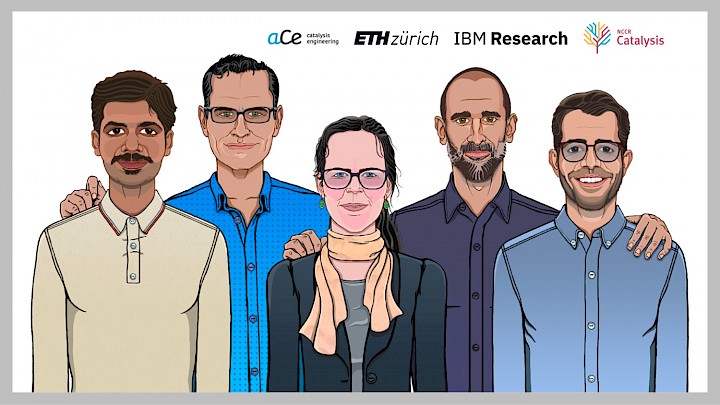
Accelerating synthesis planning for heterogeneous catalysis
Team portrait, from left to right: Manu Suvarna, Prof. Javier Pérez-Ramírez, Dr. Sharon Mitchell, Dr. Teodoro Laino, Dr. Alain Claude Vaucher. © Javier Pérez-Ramírez
In a recent collaborative publication, a team of experimental and computational experts from two NCCR Catalysis member groups have explored language models and protocol standardization guidelines to speed up synthesis planning for heterogeneous catalysts. Learn more about the work from Manu Suvarna, Dr. Sharon Mitchell and Prof. Javier Pérez-Ramírez (aCe lab, ETHZ) and Dr. Alain Vaucher and Dr. Teodoro Laino (IBM Research Zurich)!
Can you briefly introduce the concept of the project and your role?
Manu: Our project aimed at developing an automated pipeline via machine learning (ML) for the extraction of experimental synthesis procedures of single atom heterogeneous catalysts (SACs) from published literature. We used the compiled data to statistically analyze trends in SAC synthesis procedure. Eventually, based on the learning experience through the project, we identified current limitations in the way SAC-based synthesis procedures are reported, and provided guidelines to write them effectively in machine readable formats. As a PhD researcher, I wore various hats during the project, but my most important role was to translate a catalysis-oriented task into an ML problem, and serve as a bridge for exchange of insights and inferences between the two communities.
How did the collaboration between ML experts and experimental researchers come about?
Teo: The collaboration between ML experts and experimental researchers was a seamless interaction of individuals fluent in different languages - algorithms and empirical experimentation. This partnership thrived on a constant feedback loop, where ML insights informed experimental design and vice versa, elevating the quality of our research. Manu played a pivotal role by fostering curiosity and openness to learning from the ML perspective, creating an environment where diverse viewpoints flourished. This collaboration exemplifies the power of NCCR Catalysis and consequently of interdisciplinary teamwork in driving innovative breakthroughs at the intersection of technology and empirical research.
How did your experience working with experimental researchers help advance your text mining model?
Alain: The model's success was determined by its usefulness for the experimental researchers, not merely by its numerical performance. As such, we focused on tweaking the model to effectively extract what is relevant in SAC syntheses. With Manu's valuable insights, we identified and iteratively refined the model's weaknesses, ensuring it evolved to meet the precise needs of experimental researchers in this domain.
Were there any unexpected challenges that arose during the collaboration, and how did you address them?
Manu: From a technical point of view, the biggest challenge we faced was the impact of lack of data standards on model performance. Based on our experience through this project, we believe that current catalysis and chemistry literature may not be sufficiently ready to capitalize on all the benefits of language models and ML tools. In our study, we address these limitations by recommending guidelines for protocol standardization to improve machine readability. As Teo mentioned earlier, this was made possible by working in an environment where we seamlessly exchanged knowledge and shared our learning curves, to come up with an innovative solution by leveraging our respective expertise in experimental catalysis and ML.
What message or insight do you hope readers take away from your collaborative work?
Sharon: A significant takeaway is the need for experimentalists to reconsider traditional approaches in reporting synthetic protocols. In light of the crucial aspect of reproducibility of experimental results, embracing machine readable formats, like tables submitted as data files alongside articles, could greatly facilitate the integration of ML approaches to accelerate research.
Where do you see the intersection of ML and experimental research heading in the field of heterogeneous catalysis?
Teo & Manu: ML algorithms are increasingly being employed to predict catalytic properties, optimize catalyst designs, and accelerate the discovery of novel materials. The intersection of the two fields will lead to the creation of better datasets, predictive models, which will help researchers identify promising catalysts, reducing time and costs involved in experimentation. However, the field is still in its infancy and there is significant potential for the greater adoption of data-driven workflows in routine experimental works with enormous implications for chemical industry and the environment.
What role has NCCR Catalysis played in developing this work?
Javier: When we conceived NCCR Catalysis at the end of the last decade, we dreamed of studies like this one, at the interface of experimental and digital catalysis. With a cutting-edge program embracing experts in different domains, the dream has become a reality.
Publication details:
Language models and protocol standardization guidelines for accelerating synthesis planning in heterogeneous catalysis. M. Suvarna, A.C. Vaucher, S. Mitchell, T. Laino, J. Pérez-Ramírez. Nat. Commun. 2023, 14, 7964. DOI: 10.1038/s41467-023-43836-5.
In a recent collaborative publication, a team of experimental and computational experts from two NCCR Catalysis member groups have explored language models and protocol standardization guidelines to speed up synthesis planning for heterogeneous catalysts. Learn more about the work from Manu Suvarna, Dr. Sharon Mitchell and Prof. Javier Pérez-Ramírez (aCe lab, ETHZ) and Dr. Alain Vaucher and Dr. Teodoro Laino (IBM Research Zurich)!
Can you briefly introduce the concept of the project and your role?
Manu: Our project aimed at developing an automated pipeline via machine learning (ML) for the extraction of experimental synthesis procedures of single atom heterogeneous catalysts (SACs) from published literature. We used the compiled data to statistically analyze trends in SAC synthesis procedure. Eventually, based on the learning experience through the project, we identified current limitations in the way SAC-based synthesis procedures are reported, and provided guidelines to write them effectively in machine readable formats. As a PhD researcher, I wore various hats during the project, but my most important role was to translate a catalysis-oriented task into an ML problem, and serve as a bridge for exchange of insights and inferences between the two communities.
How did the collaboration between ML experts and experimental researchers come about?
Teo: The collaboration between ML experts and experimental researchers was a seamless interaction of individuals fluent in different languages - algorithms and empirical experimentation. This partnership thrived on a constant feedback loop, where ML insights informed experimental design and vice versa, elevating the quality of our research. Manu played a pivotal role by fostering curiosity and openness to learning from the ML perspective, creating an environment where diverse viewpoints flourished. This collaboration exemplifies the power of NCCR Catalysis and consequently of interdisciplinary teamwork in driving innovative breakthroughs at the intersection of technology and empirical research.
How did your experience working with experimental researchers help advance your text mining model?
Alain: The model's success was determined by its usefulness for the experimental researchers, not merely by its numerical performance. As such, we focused on tweaking the model to effectively extract what is relevant in SAC syntheses. With Manu's valuable insights, we identified and iteratively refined the model's weaknesses, ensuring it evolved to meet the precise needs of experimental researchers in this domain.
Were there any unexpected challenges that arose during the collaboration, and how did you address them?
Manu: From a technical point of view, the biggest challenge we faced was the impact of lack of data standards on model performance. Based on our experience through this project, we believe that current catalysis and chemistry literature may not be sufficiently ready to capitalize on all the benefits of language models and ML tools. In our study, we address these limitations by recommending guidelines for protocol standardization to improve machine readability. As Teo mentioned earlier, this was made possible by working in an environment where we seamlessly exchanged knowledge and shared our learning curves, to come up with an innovative solution by leveraging our respective expertise in experimental catalysis and ML.
What message or insight do you hope readers take away from your collaborative work?
Sharon: A significant takeaway is the need for experimentalists to reconsider traditional approaches in reporting synthetic protocols. In light of the crucial aspect of reproducibility of experimental results, embracing machine readable formats, like tables submitted as data files alongside articles, could greatly facilitate the integration of ML approaches to accelerate research.
Where do you see the intersection of ML and experimental research heading in the field of heterogeneous catalysis?
Teo & Manu: ML algorithms are increasingly being employed to predict catalytic properties, optimize catalyst designs, and accelerate the discovery of novel materials. The intersection of the two fields will lead to the creation of better datasets, predictive models, which will help researchers identify promising catalysts, reducing time and costs involved in experimentation. However, the field is still in its infancy and there is significant potential for the greater adoption of data-driven workflows in routine experimental works with enormous implications for chemical industry and the environment.
What role has NCCR Catalysis played in developing this work?
Javier: When we conceived NCCR Catalysis at the end of the last decade, we dreamed of studies like this one, at the interface of experimental and digital catalysis. With a cutting-edge program embracing experts in different domains, the dream has become a reality.
Publication details:
Language models and protocol standardization guidelines for accelerating synthesis planning in heterogeneous catalysis. M. Suvarna, A.C. Vaucher, S. Mitchell, T. Laino, J. Pérez-Ramírez. Nat. Commun. 2023, 14, 7964. DOI: 10.1038/s41467-023-43836-5.
20.10.2023
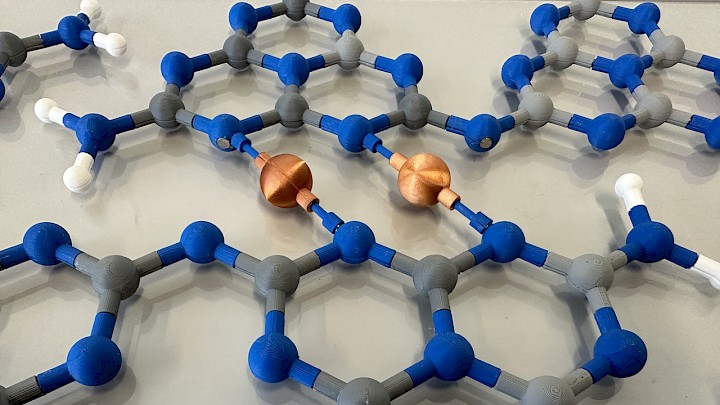
Geminal atom catalysts for more sustainable organic synthesis
In an international collaboration, researchers from the NUS, A*STAR, Tsinghua University, and ETH Zurich have explored the potential of heterogeneous geminal atom catalysts for complex molecular transformations and their environmental advantages over conventional homogeneous catalysts. In this video, NCCR Catalysis members Prof. Javier Pérez-Ramírez, Dr. Sharon Mitchell, and Prof. Gonzalo Guillén-Gosálbez from ETH Zurich share their insights about this cutting-edge research!
7.9.2023

Recipients of 2023 Young Talents Fellowship
We’re excited to announce the six recipients of our 2023 Young Talents Fellowship, who will conduct their Master theses within our member groups in fall 2023 and spring 2024. Congratulations and welcome to our network, Daphne, Christian, Iris, Gabriel, Till and Pol!
Daphne Lucidarme from Belgium studies chemistry at the University of Antwerp and will join the group of Prof. Jérôme Waser at EPFL.
Christian Zachau from Germany studies Chemistry at Freie Universität Berlin, and will join the group of Prof. Bill Morandi at ETH Zurich
Iris Nogueroles Langa from Spain studies Chemical and Bioengineering at ETH Zurich, and will join Prof. Javier Pérez-Ramírez's group at ETH Zurich
Gabriel Chaves Cathoud Pinheiro from Brazil studies Informatics and Engineering at the University of Coimbra in Portugal and will join Prof. Kjell Jorner's group at ETH Zurich.
Till Schreyer from Germany studies Chemistry at the University of Heidelberg, and will join Prof. Cristina Nevado's group at University of Zurich
Pol Gorrea Acin from Spain studies Chemistry at EPFL, and will join Prof. Xile Hu’s group at EPFL
The Young Talents Fellowship supports students with an exceptional academic record and diverse backgrounds. It provides them with the opportunity to conduct a master thesis project in a research group associated with NCCR Catalysis, and to establish their connections and ideas in a multidisciplinary, cross-fertilizing environment of research excellence. This initiative to promote fair representation in catalysis research was launched in 2022. Further editions will be announced on the link below and our social media channels.
Daphne Lucidarme from Belgium studies chemistry at the University of Antwerp and will join the group of Prof. Jérôme Waser at EPFL.
Christian Zachau from Germany studies Chemistry at Freie Universität Berlin, and will join the group of Prof. Bill Morandi at ETH Zurich
Iris Nogueroles Langa from Spain studies Chemical and Bioengineering at ETH Zurich, and will join Prof. Javier Pérez-Ramírez's group at ETH Zurich
Gabriel Chaves Cathoud Pinheiro from Brazil studies Informatics and Engineering at the University of Coimbra in Portugal and will join Prof. Kjell Jorner's group at ETH Zurich.
Till Schreyer from Germany studies Chemistry at the University of Heidelberg, and will join Prof. Cristina Nevado's group at University of Zurich
Pol Gorrea Acin from Spain studies Chemistry at EPFL, and will join Prof. Xile Hu’s group at EPFL
The Young Talents Fellowship supports students with an exceptional academic record and diverse backgrounds. It provides them with the opportunity to conduct a master thesis project in a research group associated with NCCR Catalysis, and to establish their connections and ideas in a multidisciplinary, cross-fertilizing environment of research excellence. This initiative to promote fair representation in catalysis research was launched in 2022. Further editions will be announced on the link below and our social media channels.
22.8.2023

Recipients of 2023 Turbo Grants
We are thrilled to announce the recipients of our first edition of the NCCR Catalysis Turbo Grants! This entrepreneurship program supports early-stage spin-offs in the area of sustainable chemistry and catalysis. All spin-offs are rooted in NCCR Catalysis labs, and this grant enables the researchers to dedicate their time to transitioning their research into a start-up.
We were impressed by the quality of the applications, and are glad to announce the three teams who received a 2023 Turbo Grant:
Jan Weinreich from the group of Clémence Corminboeuf at EPFL is working in the area of digital chemistry.
Benedikt Winter and Johannes Schilling from the Group of André Bardow at ETH are working in the area of digital chemistry. Since being selected, they have onboarded a third co-founder, Carl Hemprich.
Tobias Vornholt from the Thomas Ward group at UniBasel is working in the area of biocatalysis.
Congratulations to the recipients, and we're thrilled to support you as you work on your spin-offs!
We were impressed by the quality of the applications, and are glad to announce the three teams who received a 2023 Turbo Grant:
Jan Weinreich from the group of Clémence Corminboeuf at EPFL is working in the area of digital chemistry.
Benedikt Winter and Johannes Schilling from the Group of André Bardow at ETH are working in the area of digital chemistry. Since being selected, they have onboarded a third co-founder, Carl Hemprich.
Tobias Vornholt from the Thomas Ward group at UniBasel is working in the area of biocatalysis.
Congratulations to the recipients, and we're thrilled to support you as you work on your spin-offs!
8.6.2023

SCNAT Platform Chemistry Ethics Series 2023 ETH Zurich workshop
The 2023 SCNAT Platform Chemistry Ethics Series at ETH Zurich is organized by SCNAT, ETH Zurich, and its Department of Chemistry and Applied Biosciences, D-CHAB. With the union of the doctorate students, postdocs, and scientific staff of D-CHAB, VAC, and the Society for Women in Natural Sciences, WiNS, NCCR Catalysis supports this year’s workshop on Recognizing and Overcoming Bias.
The opening talks are given by Prof. Lee Penn, University of Minnesota (“Images as Representations of Reality”) and Kaila Yallum, UniBe (“Implicit Bias in Experimental Research”). Prof. Lee Penn will then address “How to Overcome Implicit Bias Everyday”, followed by interactive discussions.
The opening talks are given by Prof. Lee Penn, University of Minnesota (“Images as Representations of Reality”) and Kaila Yallum, UniBe (“Implicit Bias in Experimental Research”). Prof. Lee Penn will then address “How to Overcome Implicit Bias Everyday”, followed by interactive discussions.
30.5.2023

Science communication seminar with Dr. Fernando Gomollón-Bel
We have the pleasure of welcoming Dr. Fernando Gomollón-Bel for a science communication seminar on Beyond publishing papers: learn some Sci Comm tips and tricks. Fer is a well-known science communicator in the field of chemistry and materials, and co-founder of Agatha Communications, a small science communication agency based in the UK.
The seminar is open to all, and you can still sign up here.
The seminar is open to all, and you can still sign up here.
27.3.2023
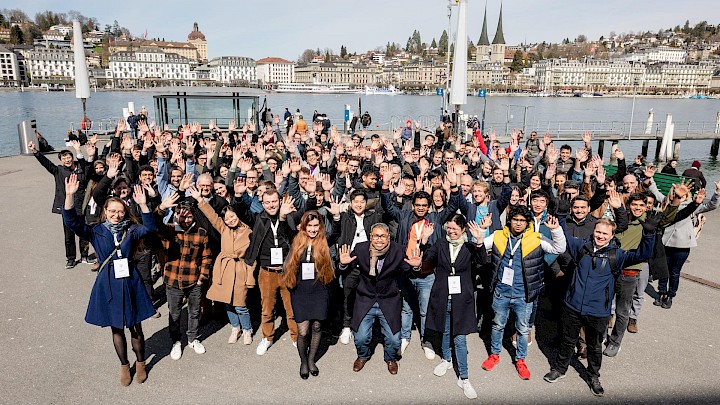
NCCR Catalysis Annual Retreat 2023
On March 27-29 2023, NCCR Catalysis held its Annual Retreat in Lucerne, Switzerland. We welcomed 150 members of our network and spent three exciting days filled with sustainable chemistry research presented by our talents, brainstorming on program activities and exchanges. It was wonderful to have our second network-wide meeting, and to connect in person!
We heard excellent presentations by the 2022 Young Talents Fellowship recipients, and talks and posters by PhD students and researchers across all five WPs. We're excited to announce the following awards:
Best Talks: Andrea Ruiz, Lopez group, ICIQ and Kevin Rossi, Pérez-Ramírez group, ETH Zurich; Ludovic Zaza, Buonsanti group, EPFL and Bojana Ranković, Schwaller group, EPFL
Best Poster: Maxime Hedou, Marti group, HES-SO
Best Poster Runner-Ups: Nieves Ramirez, Waser group, EPFL; Sebastiano D’Angelo, Guillén-Gosálbez group, ETH Zurich; and Stephan Pollitt, Nachtegaal/Safonova group, PSI
Congratulations to all awardees and many thanks to all participants for making this a fantastic community-wide event!
We heard excellent presentations by the 2022 Young Talents Fellowship recipients, and talks and posters by PhD students and researchers across all five WPs. We're excited to announce the following awards:
Best Talks: Andrea Ruiz, Lopez group, ICIQ and Kevin Rossi, Pérez-Ramírez group, ETH Zurich; Ludovic Zaza, Buonsanti group, EPFL and Bojana Ranković, Schwaller group, EPFL
Best Poster: Maxime Hedou, Marti group, HES-SO
Best Poster Runner-Ups: Nieves Ramirez, Waser group, EPFL; Sebastiano D’Angelo, Guillén-Gosálbez group, ETH Zurich; and Stephan Pollitt, Nachtegaal/Safonova group, PSI
Congratulations to all awardees and many thanks to all participants for making this a fantastic community-wide event!
1.3.2023
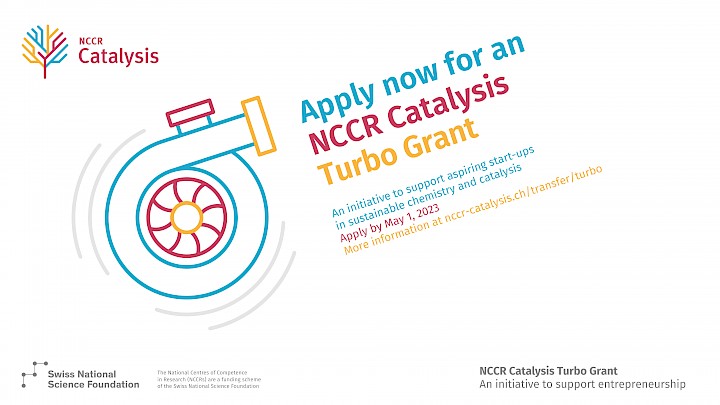
Launch of Turbo Grant
In March 2023, we launched our spin-off support program, the NCCR Catalysis Turbo Grant. With this initiative, we support research projects as they transition into a start-up company, and provide budding entrepreneurs with one year’s salary as they further develop their prototype, business plan, and assess the market. During the grant period, they are hosted in one of our NCCR Catalysis member labs, integrated as members of our network, and supported by our Project Office.
27.2.2023
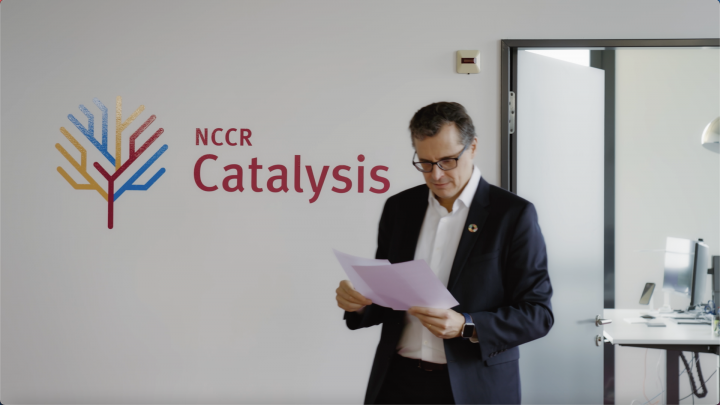
Release of statement by Director Prof. Javier Pérez-Ramírez
We are excited to release a statement by NCCR Catalysis Director Prof. Javier Pérez-Ramírez from the Department of Chemistry and Applied Biosciences at ETH Zurich. He explains why we need to switch to sustainable chemicals production urgently, addresses our program's role in this endeavor, and how we integrate sustainability into our approach. Learn more in the video!
8.2.2023
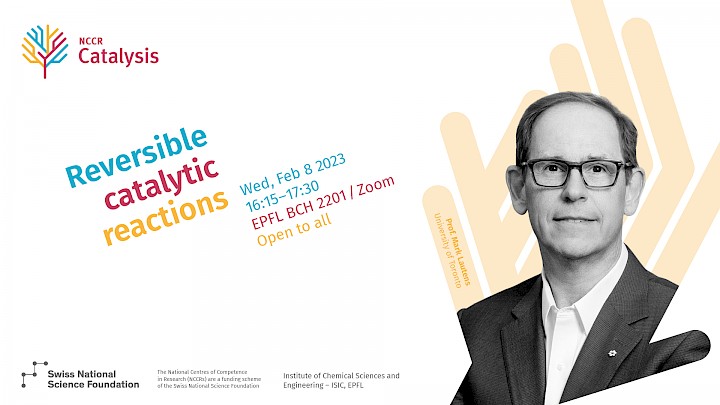
Seminar with Prof. Mark Lautens on Reversible catalytic reactions
The group of Prof. Jérôme Waser at EPFL hosted Prof. Mark Lautens as visiting professor in early 2023, where he gave a seminar on Reversible catalytic reactions.
Prof. Mark Lautens has been the J. Bryan Jones Distinguished Professor at the University of Toronto since 2013 and AstraZeneca Professor of Organic Synthesis since 1998. His group's research focuses on asymmetric catalysis with focus on rhodium, nickel and palladium catalysts, and heterocycle synthesis using metal catalysts.
Prof. Mark Lautens has been the J. Bryan Jones Distinguished Professor at the University of Toronto since 2013 and AstraZeneca Professor of Organic Synthesis since 1998. His group's research focuses on asymmetric catalysis with focus on rhodium, nickel and palladium catalysts, and heterocycle synthesis using metal catalysts.
1.2.2023

Arnold (Abel) Gimeno joins as Administrative Assistant
Arnold (Abel) Gimeno joined our Project Office team in February as Administrative Assistant. He has extensive international experience in dealing with administrative matters. Welcome to the team, Abel!
9.1.2023

Kjell Jorner starts as Assistant Professor of Digital Chemistry
Prof. Kjell Jorner was appointed in May 2022 as Assistant Professor of Digital Chemistry at ETH Zurich’s Department of Chemistry and Applied Biosciences. He fills one of the three Assistant Professorship positions at ETH Zurich and EPFL embedded in NCCR Catalysis. We’re pleased to finally welcome you to our network and we wish you a great start, Kjell!
1.1.2023

Romain Graux joins as Data Officer
Romain Graux joined our Project Office team in January as Data Officer. He recently completed his master's degree in Data Science, and his expertise in this field will be instrumental in advancing our organization's data-driven initiatives. Welcome to the team, Romain!
22.11.2022

Lecture by Prof. Heather J. Kulik on ML-accelerated computational materials discovery
We have the pleasure of welcoming Prof. Heather J. Kulik for an open-to-all lecture on Addressing challenges of data scarcity and quality in ML-accelerated computational materials discovery, co-organized with the Laboratory of Inorganic Chemistry (LAC) at ETH Zurich.
Prof. Heather J. Kulik is an Associate Professor in Chemical Engineering at MIT. Her research group focuses on computational chemistry, chemical engineering, and materials science for a wide range of applications from fundamental biochemistry to data-driven discovery of new molecules and materials.
Prof. Heather J. Kulik is an Associate Professor in Chemical Engineering at MIT. Her research group focuses on computational chemistry, chemical engineering, and materials science for a wide range of applications from fundamental biochemistry to data-driven discovery of new molecules and materials.
14.11.2022
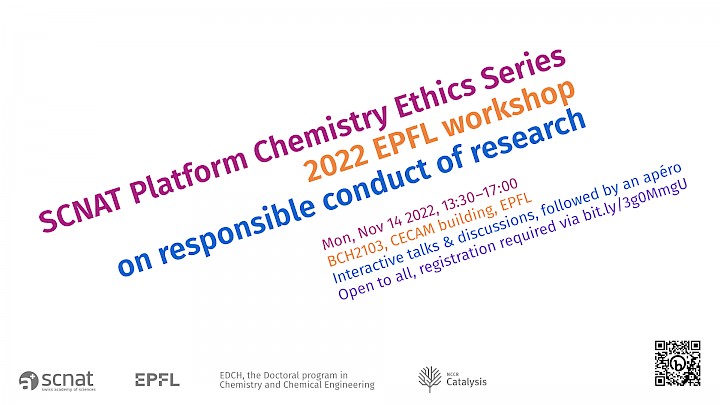
SCNAT Platform Chemistry Ethics Series 2022 EPFL workshop
The 2022 re-launch of the SCNAT Platform Chemistry Ethics Series at EPFL was organized by SCNAT, EPFL, EDCH (its doctoral program in chemistry and chemical engineering), and NCCR Catalysis.
The event started with talks by Prof. Edward Constable (president of the Swiss Academies' Committee for Research Integrity, Prof. University of Basel) and Prof. Antonio Togni (former Vice Rector for Doctoral Studies, Prof. em. ETH Zurich) on "Surely it doesn’t apply to me? Equating integrity with best practice"and "Orchestrating relevance: A questionable trait of modern publication culture", respectively, moderated by Prof. Jérôme Waser from EPFL, substituting for Prof. Shana Sturla from ETH Zurich. The speakers and panelists then led interactive discussion rounds, on which participants reported to the plenary. The afternoon concluded with an apéro.
The organizers included Prof. Shana Sturla and Dr. Leo Merz, SCNAT; Prof. Berend Smit and Anne Lene Odegaard, EPFL and EDCH; and Dr. Marie Francine Lagadec, NCCR Catalysis.
The event started with talks by Prof. Edward Constable (president of the Swiss Academies' Committee for Research Integrity, Prof. University of Basel) and Prof. Antonio Togni (former Vice Rector for Doctoral Studies, Prof. em. ETH Zurich) on "Surely it doesn’t apply to me? Equating integrity with best practice"and "Orchestrating relevance: A questionable trait of modern publication culture", respectively, moderated by Prof. Jérôme Waser from EPFL, substituting for Prof. Shana Sturla from ETH Zurich. The speakers and panelists then led interactive discussion rounds, on which participants reported to the plenary. The afternoon concluded with an apéro.
The organizers included Prof. Shana Sturla and Dr. Leo Merz, SCNAT; Prof. Berend Smit and Anne Lene Odegaard, EPFL and EDCH; and Dr. Marie Francine Lagadec, NCCR Catalysis.
18.10.2022
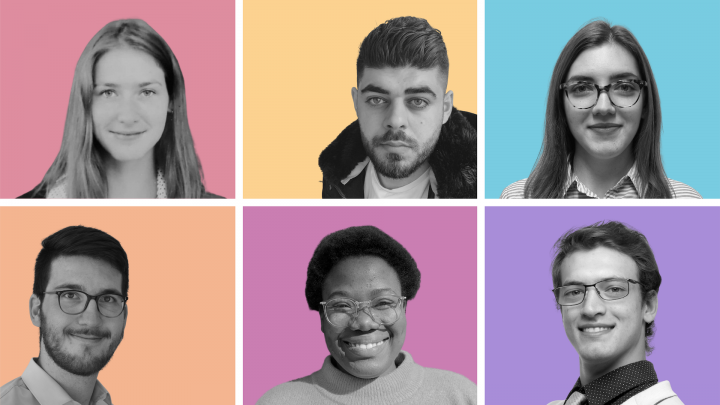
Recipients of 2022 Young Talents Fellowship
We’re excited to announce the six recipients of our 2022 Young Talents Fellowship, who will conduct their Master theses within our member groups in fall 2022/spring 2023. Congratulations and welcome to our network, Morgane, Layth, Gabriela, Nicolas, Gloria and Adrián!
Morgane Delattre from France studies Organic Chemistry at CPE Lyon, and is an exchange student at EPFL, where she joined the group of Prof. Jieping Zhu.
Layth Alama from Palestine studies Chemistry at the Free University of Berlin, and will join Prof. Nicolai Cramer’s group at EPFL.
Gabriela Dutcă from Romania studies Chemical Engineering at the University of Groningen, and joined Prof. Javier Pérez-Ramírez’s group at ETH Zurich.
Nicolas Imstepf from Switzerland studies Life Sciences at the Zurich University of Applied Sciences, ZHAW, and joined the group of Prof. Rebecca Buller at ZHAW.
Gloria Candy Danielle Sedoh from Togo studies Chemistry at the University of Geneva, and joined the groups of Prof. Ross Milton at University of Geneva and Prof. Kevin Sivula at EPFL.
Adrián Sager La Ganga from Spain studies Computational Science & Engineering at EPFL, and joined Dr. Teodoro Laino’s group at IBM Research.
The Young Talents Fellowship supports students with an exceptional academic record and diverse backgrounds. It provides them with the opportunity to conduct a master thesis project in a research group associated with NCCR Catalysis, and to establish their connections and ideas in a multidisciplinary, cross-fertilizing environment of research excellence. This initiative to promote fair representation in catalysis research was launched in 2022. Further editions will be announced on the link below and our social media channels.
Morgane Delattre from France studies Organic Chemistry at CPE Lyon, and is an exchange student at EPFL, where she joined the group of Prof. Jieping Zhu.
Layth Alama from Palestine studies Chemistry at the Free University of Berlin, and will join Prof. Nicolai Cramer’s group at EPFL.
Gabriela Dutcă from Romania studies Chemical Engineering at the University of Groningen, and joined Prof. Javier Pérez-Ramírez’s group at ETH Zurich.
Nicolas Imstepf from Switzerland studies Life Sciences at the Zurich University of Applied Sciences, ZHAW, and joined the group of Prof. Rebecca Buller at ZHAW.
Gloria Candy Danielle Sedoh from Togo studies Chemistry at the University of Geneva, and joined the groups of Prof. Ross Milton at University of Geneva and Prof. Kevin Sivula at EPFL.
Adrián Sager La Ganga from Spain studies Computational Science & Engineering at EPFL, and joined Dr. Teodoro Laino’s group at IBM Research.
The Young Talents Fellowship supports students with an exceptional academic record and diverse backgrounds. It provides them with the opportunity to conduct a master thesis project in a research group associated with NCCR Catalysis, and to establish their connections and ideas in a multidisciplinary, cross-fertilizing environment of research excellence. This initiative to promote fair representation in catalysis research was launched in 2022. Further editions will be announced on the link below and our social media channels.
27.6.2022
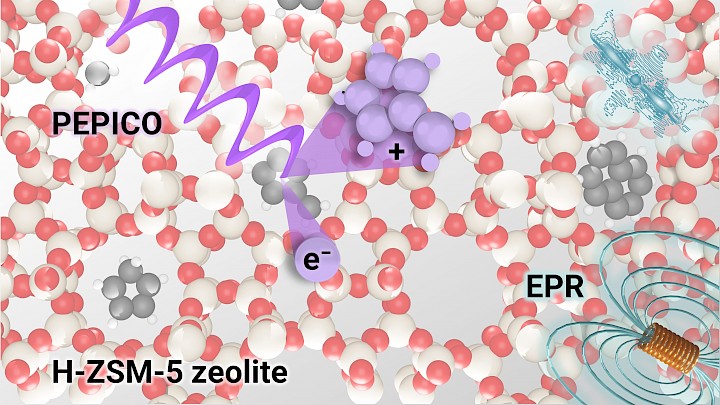
Reaction insights help make sustainable liquid fuels
Methanol, produced from carbon dioxide in the air, can be used to make carbon neutral fuels. But to do this, the mechanism by which methanol is turned into liquid hydrocarbons must be better understood so that the catalytic process can be optimised. Now, using sophisticated analytical techniques, researchers from ETH Zurich and Paul Scherrer Institute have gained unprecedented insight into this complex mechanism.
As we struggle to juggle the impact of emissions with our desire to maintain our energy hungry lifestyle, using carbon dioxide in the atmosphere to create new fuels is an exciting, carbon neutral alternative. One way to do this is to create methanol from carbon dioxide in the air, using a process called hydrogenation. This methanol can then be converted into hydrocarbons. Although these are then burnt, releasing carbon dioxide, this is balanced by carbon dioxide captured to make the fuel.
To fully develop this sustainable fuel, a deeper understanding of the mechanism by which methanol - in a reaction catalysed by zeolites, solid materials with unique porous architectures - is turned into long chain hydrocarbons, is necessary. With this in mind, in the frame of NCCR Catalysis, a Swiss National Center of Competence in Research, researchers from ETH Zurich joined forces with researchers from the Paul Scherrer Institut, PSI to reveal the details of this reaction mechanism, the findings of which are published in the journal Nature Catalysis.
“Information is key to developing more selective and stable catalysts,” explains Javier Pérez-Ramírez, Professor of Catalysis Engineering at ETH Zurich and director of NCCR Catalysis, who co-led the study. “Prior to our study, despite many efforts, key mechanistic aspects of the complex transformation of methanol into hydrocarbons were not well understood”.
The researchers were interested in comparing the methanol to hydrocarbon process with another process: that of turning methyl chloride into hydrocarbons. Oil refineries frequently burn large quantities of unwanted methane rich natural gas. This polluting and wasteful activity results in the typical flares associated with oil refineries. “Turning methyl chloride into hydrocarbons is a kind of bridge technology,” explains Pérez-Ramírez. “Of course, we would like to move away from fossil fuels but in the meantime this would be a way to avoid wasting the vast reserves of valuable methane”.Fleeting gas phase molecules tell the story
Key to understanding complex reaction mechanisms such as these is to detect the different species involved, including the intermediate products. Traditional techniques look directly at the surface of the catalyst to understand the reaction, but an important part of the story is told by gas phase molecules, which come off the catalyst.
“These molecules are often highly reactive and very short lived, decomposing within a few milliseconds. This makes identifying them a real challenge, as traditional gas phase analytical methods are simply too slow,” explains Patrick Hemberger, scientist at the vacuum ultra violet (VUV) beamline of the Swiss Light Source SLS, whose sophisticated analytical techniques would enable the researchers to study the reaction as it happened.
At the VUV beamline, Photoion Photoelectron Coincidence (PEPICO) spectroscopy has recently been established as a powerful analytical tool in catalytic reactions. It combines two different analytical techniques, photoelectron spectroscopy and mass spectrometry, to give detailed information on the gas phase reaction intermediates, even enabling differentiation between isomers.
“Because we simultaneously gather two different types of information, we can rapidly identify these fleeting species even in a mixture containing up to one hundred reaction intermediates and products. This gives us an unprecedented insight that simply isn’t possible with conventional methods,” Hemberger says.
Researchers (from left to right) Javier Pérez-Ramírez, András Bödi and Patrick Hemberger at the Swiss Light Source SLS (Photo: Paul Scherrer Institute / Markus Fischer).Reaction pathways revealed
The spectroscopy enabled the researchers to reveal how the carbon-carbon bonds form and the hydrocarbon chain grows by detecting numerous intermediate products. For the two processes – methanol to hydrocarbon and methyl chloride to hydrocarbon – the researchers observed that different reaction intermediates were occurring. From this, they could identify two distinct reaction pathways, one driven by methyl radicals, present in both reactions, and another driven by oxygenated species, so-called ketenes, which occurred only in the methanol to hydrocarbon reaction.
The researchers were also able to understand an interesting feature of the reactions: after several days, the catalyst was deactivated and the reaction stopped. This was because of the build-up of an unwanted by-product – coke, which is made from large aromatic hydrocarbons deposited during the reaction.
With the help of another spectroscopic technique, electron paramagnetic resonance spectroscopy, the researchers saw that the methyl chloride to hydrocarbon production was much more prone to coke formation than production from methanol. Armed with knowledge of the reaction pathways, the reason for this difference was clear: “The methanol to hydrocarbon route proceeds along two reaction pathways, whilst the methyl chloride to hydrocarbon route can only take the more reactive methyl radical route, which is more prone to forming coke,” explains Gunnar Jeschke, whose team at ETH Zurich performed the electron paramagnetic resonance spectroscopy studies.
Understanding the mechanism to optimise the process
The insight gained by this study is essential for the future development of liquid fuels in a sustainable manner. This could include finding ways to enhance the oxygen driven pathway, thus suppressing the formation of coke.
“We now have a deeper understanding of the reaction mechanism of methanol to hydrocarbons or methyl chloride to hydrocarbons and with this knowledge we can optimise the industrial process in a targeted way to make it more efficient,” adds Hemberger.Text and photo credit:
Paul Scherrer Institute / Miriam ArrellPublication details:Elucidation of radical- and oxygenate-driven paths in zeolite-catalysed conversion of methanol and methyl chloride to hydrocarbonsA. Cesarini, S. Mitchell, G. Zichittella, M. Agrachev, S.P. Schmid, G. Jeschke, Z. Pan, A. Bodi, P. Hemberger, J. Pérez-RamírezNat. Catal. 2022, in press (doi:10.1038/s41929-022-00808-0)
As we struggle to juggle the impact of emissions with our desire to maintain our energy hungry lifestyle, using carbon dioxide in the atmosphere to create new fuels is an exciting, carbon neutral alternative. One way to do this is to create methanol from carbon dioxide in the air, using a process called hydrogenation. This methanol can then be converted into hydrocarbons. Although these are then burnt, releasing carbon dioxide, this is balanced by carbon dioxide captured to make the fuel.
To fully develop this sustainable fuel, a deeper understanding of the mechanism by which methanol - in a reaction catalysed by zeolites, solid materials with unique porous architectures - is turned into long chain hydrocarbons, is necessary. With this in mind, in the frame of NCCR Catalysis, a Swiss National Center of Competence in Research, researchers from ETH Zurich joined forces with researchers from the Paul Scherrer Institut, PSI to reveal the details of this reaction mechanism, the findings of which are published in the journal Nature Catalysis.
“Information is key to developing more selective and stable catalysts,” explains Javier Pérez-Ramírez, Professor of Catalysis Engineering at ETH Zurich and director of NCCR Catalysis, who co-led the study. “Prior to our study, despite many efforts, key mechanistic aspects of the complex transformation of methanol into hydrocarbons were not well understood”.
The researchers were interested in comparing the methanol to hydrocarbon process with another process: that of turning methyl chloride into hydrocarbons. Oil refineries frequently burn large quantities of unwanted methane rich natural gas. This polluting and wasteful activity results in the typical flares associated with oil refineries. “Turning methyl chloride into hydrocarbons is a kind of bridge technology,” explains Pérez-Ramírez. “Of course, we would like to move away from fossil fuels but in the meantime this would be a way to avoid wasting the vast reserves of valuable methane”.Fleeting gas phase molecules tell the story
Key to understanding complex reaction mechanisms such as these is to detect the different species involved, including the intermediate products. Traditional techniques look directly at the surface of the catalyst to understand the reaction, but an important part of the story is told by gas phase molecules, which come off the catalyst.
“These molecules are often highly reactive and very short lived, decomposing within a few milliseconds. This makes identifying them a real challenge, as traditional gas phase analytical methods are simply too slow,” explains Patrick Hemberger, scientist at the vacuum ultra violet (VUV) beamline of the Swiss Light Source SLS, whose sophisticated analytical techniques would enable the researchers to study the reaction as it happened.
At the VUV beamline, Photoion Photoelectron Coincidence (PEPICO) spectroscopy has recently been established as a powerful analytical tool in catalytic reactions. It combines two different analytical techniques, photoelectron spectroscopy and mass spectrometry, to give detailed information on the gas phase reaction intermediates, even enabling differentiation between isomers.
“Because we simultaneously gather two different types of information, we can rapidly identify these fleeting species even in a mixture containing up to one hundred reaction intermediates and products. This gives us an unprecedented insight that simply isn’t possible with conventional methods,” Hemberger says.
Researchers (from left to right) Javier Pérez-Ramírez, András Bödi and Patrick Hemberger at the Swiss Light Source SLS (Photo: Paul Scherrer Institute / Markus Fischer).Reaction pathways revealed
The spectroscopy enabled the researchers to reveal how the carbon-carbon bonds form and the hydrocarbon chain grows by detecting numerous intermediate products. For the two processes – methanol to hydrocarbon and methyl chloride to hydrocarbon – the researchers observed that different reaction intermediates were occurring. From this, they could identify two distinct reaction pathways, one driven by methyl radicals, present in both reactions, and another driven by oxygenated species, so-called ketenes, which occurred only in the methanol to hydrocarbon reaction.
The researchers were also able to understand an interesting feature of the reactions: after several days, the catalyst was deactivated and the reaction stopped. This was because of the build-up of an unwanted by-product – coke, which is made from large aromatic hydrocarbons deposited during the reaction.
With the help of another spectroscopic technique, electron paramagnetic resonance spectroscopy, the researchers saw that the methyl chloride to hydrocarbon production was much more prone to coke formation than production from methanol. Armed with knowledge of the reaction pathways, the reason for this difference was clear: “The methanol to hydrocarbon route proceeds along two reaction pathways, whilst the methyl chloride to hydrocarbon route can only take the more reactive methyl radical route, which is more prone to forming coke,” explains Gunnar Jeschke, whose team at ETH Zurich performed the electron paramagnetic resonance spectroscopy studies.
Understanding the mechanism to optimise the process
The insight gained by this study is essential for the future development of liquid fuels in a sustainable manner. This could include finding ways to enhance the oxygen driven pathway, thus suppressing the formation of coke.
“We now have a deeper understanding of the reaction mechanism of methanol to hydrocarbons or methyl chloride to hydrocarbons and with this knowledge we can optimise the industrial process in a targeted way to make it more efficient,” adds Hemberger.Text and photo credit:
Paul Scherrer Institute / Miriam ArrellPublication details:Elucidation of radical- and oxygenate-driven paths in zeolite-catalysed conversion of methanol and methyl chloride to hydrocarbonsA. Cesarini, S. Mitchell, G. Zichittella, M. Agrachev, S.P. Schmid, G. Jeschke, Z. Pan, A. Bodi, P. Hemberger, J. Pérez-RamírezNat. Catal. 2022, in press (doi:10.1038/s41929-022-00808-0)
21.6.2022
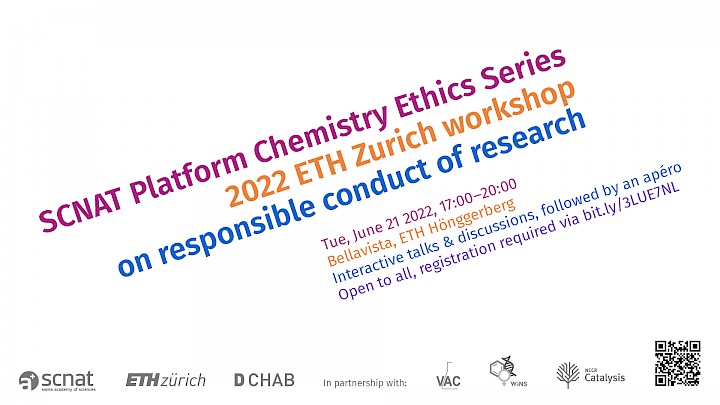
SCNAT Platform Chemistry Ethics Series 2022 ETH Zurich workshop
The 2022 re-launch of the SCNAT Platform Chemistry Ethics Series at ETH Zurich was organized by SCNAT, ETH Zurich and its Department of Chemistry and Applied Biosciences, D-CHAB. Together with the union of the doctorate students, postdocs and scientific staff of D-CHAB, VAC and of the Society for Women in Natural Sciences, WiNS, NCCR Catalysis supported this year’s workshop on responsible conduct of research.
The event started with talks by Prof. Edward Constable (president of the Swiss Academies' Committee for Research Integrity, Prof. University of Basel) and Prof. Antonio Togni (former Vice Rector for Doctoral Studies, Prof. em. ETHZ) on "Surely it doesn’t apply to me? Equating integrity with best practice" and "Orchestrating relevance: A questionable trait of modern publication culture", respectively, moderated by Prof. Shana Sturla. The speakers and panelists from VAC, WiNS and NCCR Catalysis then led interactive discussion rounds, on which participants reported to the plenary. The evening concluded with an apéro.
The organizers included Prof. Shana Sturla and Dr. Leo Merz, SCNAT; Prof. Christophe Copéret, D-CHAB; Moritz Bernhardt, VAC; Dr. Monika Colombo, WiNS; and Dr. Marie Francine Lagadec, NCCR Catalysis.
The event started with talks by Prof. Edward Constable (president of the Swiss Academies' Committee for Research Integrity, Prof. University of Basel) and Prof. Antonio Togni (former Vice Rector for Doctoral Studies, Prof. em. ETHZ) on "Surely it doesn’t apply to me? Equating integrity with best practice" and "Orchestrating relevance: A questionable trait of modern publication culture", respectively, moderated by Prof. Shana Sturla. The speakers and panelists from VAC, WiNS and NCCR Catalysis then led interactive discussion rounds, on which participants reported to the plenary. The evening concluded with an apéro.
The organizers included Prof. Shana Sturla and Dr. Leo Merz, SCNAT; Prof. Christophe Copéret, D-CHAB; Moritz Bernhardt, VAC; Dr. Monika Colombo, WiNS; and Dr. Marie Francine Lagadec, NCCR Catalysis.
20.6.2022
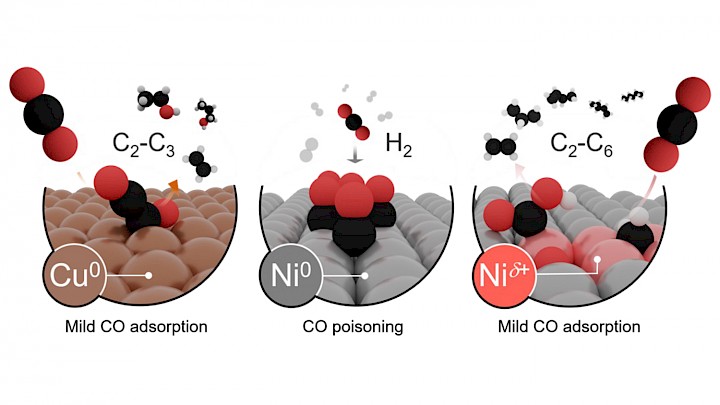
Nickel electrocatalysts for one-step synthesis of long hydrocarbons from CO2
A collaboration supported by NCCR Catalysis between the groups of Profs. J. Pérez-Ramírez at ETH Zurich, B.S. Yeo at the National University of Singapore (NUS), and N. López at the Institute of Chemical Research of Catalonia (ICIQ) has led to the discovery of a new family of materials able to transform electrocatalytically carbon dioxide into long hydrocarbons at room temperature and pressure. After four decades of intense research efforts, no more than three carbon dioxide molecules could be coupled in a single step at appreciable rates over electrocatalysts based exclusively on copper. The products obtained were ethylene, ethanol and propanol. In contrast, the new family of nickel-based catalysts can couple up to six CO2, giving direct access now to a richer pool of products, with selectivities to linear and branched hydrocarbons of 16% and up to 7% to C3-C6 products. These breakthrough results have been recently published in Nature Catalysis.
The formation of long carbon products was detected during a search for alternative catalysts to copper. Metallic nickel is typically a poor CO2 reduction catalyst because it adsorbs carbon monoxide, a key intermediate in the reaction, too strongly, stopping the reaction. However, using inorganic nickel oxygenates such as nickel phosphate or carbonate, the team could identify up to 28 different products. Extensive experimental and computational efforts managed to identify the key to the unique performance: the ability to keep a few nickel-oxygen bonds in the electrode during the reaction. This generates polarized nickel atoms (Nid+) that only weakly adsorb carbon monoxide, enabling the coupling of carbon species. These results encourage further research towards the implementation of Ni-based technologies in the future. The team is already working to exploit the new research avenue these catalysts open, as they think we may have only scratched their potential. More information available in https://doi.org/10.1038/s41929-022-00803-5.Image credit:
Javier Pérez-RamírezPublication details:Long-chain hydrocarbons via CO2 electroreduction enabled by polarized nickel catalysts
Y. Zhou, A.J. Martín, F. Dattila, S. Xi, N. López, J. Pérez-Ramírez, B.S. YeoNat. Catal. 2022, in press (doi:10.1038/s41929-022-00803-5)
The formation of long carbon products was detected during a search for alternative catalysts to copper. Metallic nickel is typically a poor CO2 reduction catalyst because it adsorbs carbon monoxide, a key intermediate in the reaction, too strongly, stopping the reaction. However, using inorganic nickel oxygenates such as nickel phosphate or carbonate, the team could identify up to 28 different products. Extensive experimental and computational efforts managed to identify the key to the unique performance: the ability to keep a few nickel-oxygen bonds in the electrode during the reaction. This generates polarized nickel atoms (Nid+) that only weakly adsorb carbon monoxide, enabling the coupling of carbon species. These results encourage further research towards the implementation of Ni-based technologies in the future. The team is already working to exploit the new research avenue these catalysts open, as they think we may have only scratched their potential. More information available in https://doi.org/10.1038/s41929-022-00803-5.Image credit:
Javier Pérez-RamírezPublication details:Long-chain hydrocarbons via CO2 electroreduction enabled by polarized nickel catalysts
Y. Zhou, A.J. Martín, F. Dattila, S. Xi, N. López, J. Pérez-Ramírez, B.S. YeoNat. Catal. 2022, in press (doi:10.1038/s41929-022-00803-5)
10.6.2022
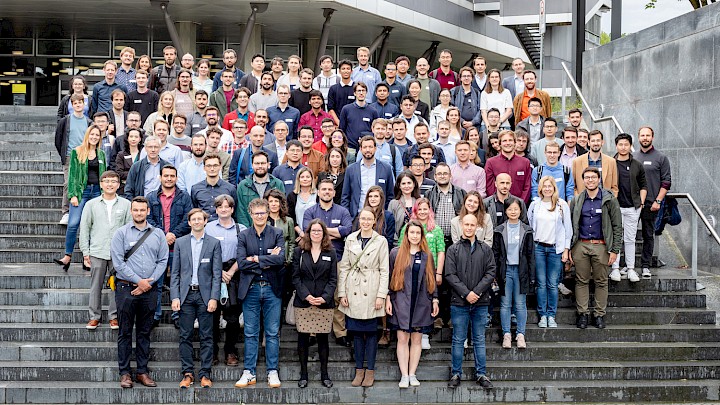
NCCR Catalysis Annual Event 2022
On June 9-10 2022, NCCR Catalysis held its first Annual Event at ETH Zurich, Campus Hönggerberg. We welcomed 145 members of our network and spent two exciting days filled with catalysis and sustainable chemistry research presented by our talents. It was a wonderful to have our first physical meeting after 22 months of operation, and to connect in person!
We saw excellent presentations and posters by PhD students and researchers across all five WPs and are excited to announce the following awards:
Best Talk: Anastasiia Komarova, Luterbacher group, EPFL
Runner Up Talks: Thomas Moragues, deMello group, ETH Zurich and Mojmir Mutny, Krause group, ETH Zurich
Best Poster: Alessandra Toniato, Laino group, IBM Research Zurich
Runner Up Posters: Ludovic Zaza, Buonsanti group, EPFL and Lukas Spiekermann, Bardow group, ETH Zurich
Congratulations to all awardees and many thanks to all participants for making this a fantastic community-wide event!
We saw excellent presentations and posters by PhD students and researchers across all five WPs and are excited to announce the following awards:
Best Talk: Anastasiia Komarova, Luterbacher group, EPFL
Runner Up Talks: Thomas Moragues, deMello group, ETH Zurich and Mojmir Mutny, Krause group, ETH Zurich
Best Poster: Alessandra Toniato, Laino group, IBM Research Zurich
Runner Up Posters: Ludovic Zaza, Buonsanti group, EPFL and Lukas Spiekermann, Bardow group, ETH Zurich
Congratulations to all awardees and many thanks to all participants for making this a fantastic community-wide event!
8.6.2022
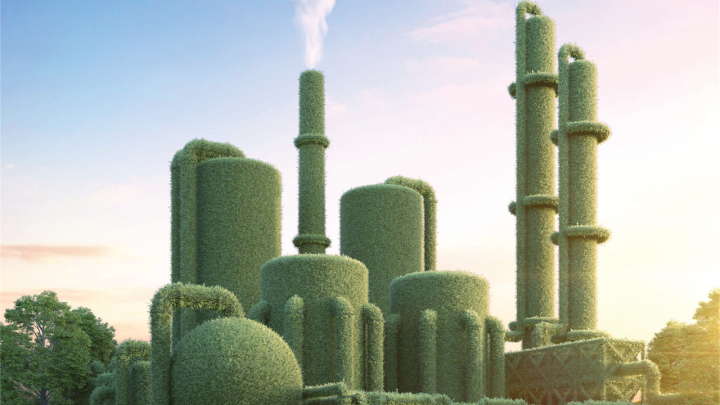
Release of video on sustainability of chemicals through the lens of planetary boundaries
We had a great time shooting a video with the teams of Prof. Javier Pérez-Ramírez and Prof. Gonzalo Guillén-Gosálbez from ETH Zurich on their NCCR Catalysis study on sustainability assessments of chemicals production, and are excited to see it released!
The teams investigated whether the production of the 492 most relevant chemicals is sustainable with respect to transgression of planetary boundaries. In this NCCR Catalysis study, they found that 99.4% of these chemicals exceed at least one such boundary, which makes them unsustainable in the long term. Learn more about their findings in the video and the publication!
The teams investigated whether the production of the 492 most relevant chemicals is sustainable with respect to transgression of planetary boundaries. In this NCCR Catalysis study, they found that 99.4% of these chemicals exceed at least one such boundary, which makes them unsustainable in the long term. Learn more about their findings in the video and the publication!
31.5.2022
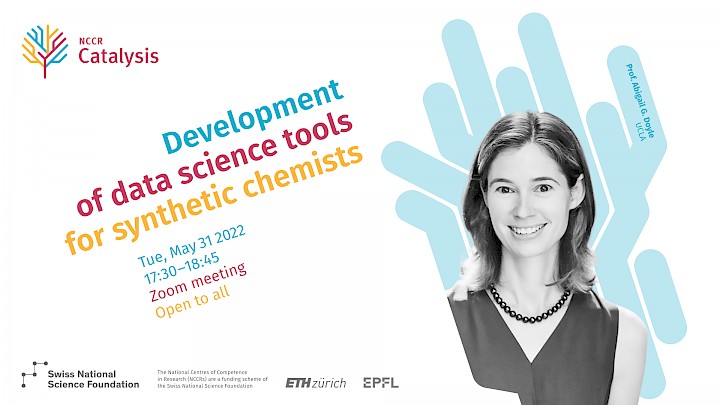
Seminar with Prof. Abigail G. Doyle on data science tools for synthetic chemists
We had the pleasure of welcoming Prof. Abigail G. Doyle for an open-to-all seminar on Development of data science tools for synthetic chemists, co-organized with Dr. Teodoro Laino.
Prof. Abigail G. Doyle is the Saul Winstein Chair in Organic Chemistry at UCLA since 2021, previously the A. Barton Hepburn Professor of Chemistry at Princeton University. Her group's research focuses on the interface of organic, organometallic, physical organic, and computational chemistry. They develop catalysts, catalytic reactions, and synthetic methods, also applying mechanistic and computer-assisted techniques to understand the principles guiding these catalytic reactions.
Prof. Abigail G. Doyle is the Saul Winstein Chair in Organic Chemistry at UCLA since 2021, previously the A. Barton Hepburn Professor of Chemistry at Princeton University. Her group's research focuses on the interface of organic, organometallic, physical organic, and computational chemistry. They develop catalysts, catalytic reactions, and synthetic methods, also applying mechanistic and computer-assisted techniques to understand the principles guiding these catalytic reactions.
12.5.2022
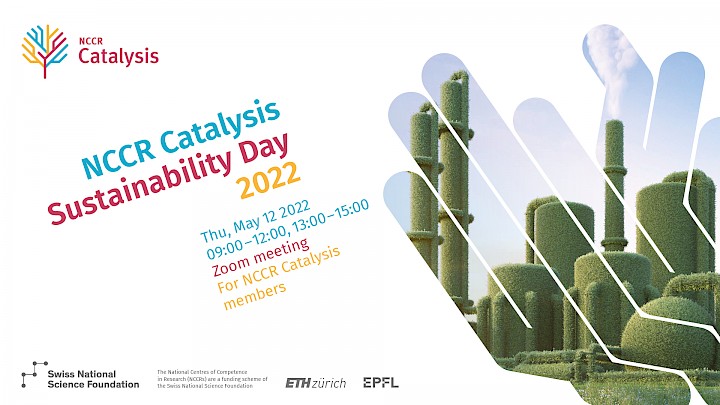
NCCR Catalysis Sustainability Day 2022
On May 12 2022, NCCR Catalysis held its first Sustainability Day. The morning session combined lectures from experts bringing industry and academic perspectives on sustainability assessment with a panel discussion.
The afternoon covered the status quo within NCCR Catalysis and provided an opportunity for brainstorming on how to address sustainability moving forward. We thank all speakers, moderators and participants for their contributions and lively discussions!
The afternoon covered the status quo within NCCR Catalysis and provided an opportunity for brainstorming on how to address sustainability moving forward. We thank all speakers, moderators and participants for their contributions and lively discussions!
19.4.2022
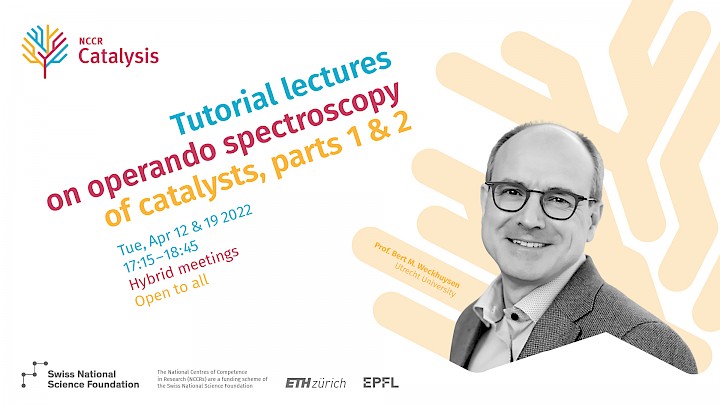
Tutorial lectures by Prof. Bert Weckhuysen on operando spectroscopy of catalysts
We had the pleasure of welcoming Prof. Bert M. Weckhuysen for two tutorial lectures held in hybrid mode. In part 1, Prof. Weckhuysen led us through the history, social network of the community, trends and practical aspects of operando spectroscopy of catalysts.
In part 2, he discussed cell design suggestions, and advances towards capturing molecular movies of real-life catalysts. We thank Prof. Weckhuysen for the insightful lectures, the group of Prof. Christophe Copéret for organizing, and all attendees for joining us! You can find the lecture recordings on our YouTube channel: part 1 and part 2.
Prof. Bert M. Weckhuysen is a full professor at Utrecht University, where his group focuses on the development of structure-activity relationships and expert systems in the field of heterogeneous catalysis and materials science. His research group places special emphasis on the development and use of advanced in situ characterization techniques. He is currently a visiting professor in Prof. Christophe Copéret’s group at the Department of Chemistry and Applied Biosciences at ETH Zurich, and member of the NCCR Catalysis International Advisory Board.
In part 2, he discussed cell design suggestions, and advances towards capturing molecular movies of real-life catalysts. We thank Prof. Weckhuysen for the insightful lectures, the group of Prof. Christophe Copéret for organizing, and all attendees for joining us! You can find the lecture recordings on our YouTube channel: part 1 and part 2.
Prof. Bert M. Weckhuysen is a full professor at Utrecht University, where his group focuses on the development of structure-activity relationships and expert systems in the field of heterogeneous catalysis and materials science. His research group places special emphasis on the development and use of advanced in situ characterization techniques. He is currently a visiting professor in Prof. Christophe Copéret’s group at the Department of Chemistry and Applied Biosciences at ETH Zurich, and member of the NCCR Catalysis International Advisory Board.
4.4.2022

Launch of short explainer animation
We're excited to launch a short animation to introduce NCCR Catalysis to the broad public and to make our research accessible beyond the catalysis community.
Learn more about our program in English, German and French!
Learn more about our program in English, German and French!
31.3.2022
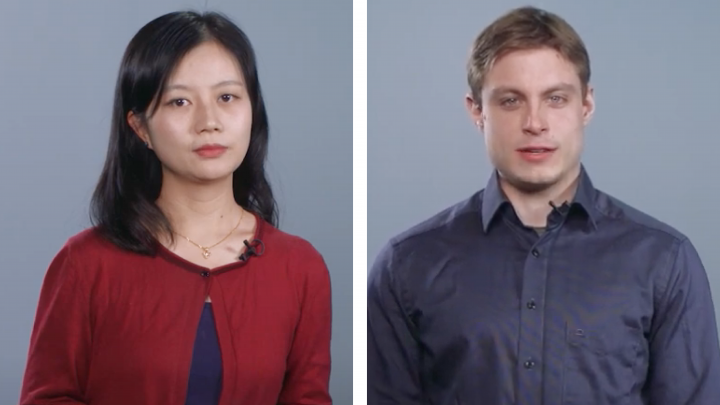
Videos on life cycle assessment of chemicals
PhD student Jing Huo and postdoctoral researcher Dr. Eric Bradford, both working in the group of Prof. Stefanie Hellweg, Core PI at ETH Zurich, summarized their NCCR Catalysis projects in short videos. Their work addresses evaluation of the environmental sustainability of a broad range of chemical products and processes, including catalysts, at an early design stage.
The goal of Jing's work is to inform the chemical industry and policymakers about which strategies to pursue in transitioning to renewable feedstocks. Therefore, she aims to provide a holistic comparison of environmental benefits and trade-offs of chemicals produced from different feedstocks and pathways under different scenarios. The work focuses on CO2 and biomass as chemical feedstocks, including their future regional supply-demand balance and environmental impacts based on projected sourcing mechanisms. A case study will address the optimization potential of upstream supply chain of the chemical manufacturing sites in Europe, with the aim of minimizing total environmental impacts from feedstock sourcing, transportation, and conversion.Eric's work focuses on developing a pre-life cycle assessment (LCA) framework for evaluating new chemicals. Currently, life-cycle inventories are lacking for most chemicals, which hampers assessments of their environmental impact. While over 100 million chemicals are registered, LCAs cannot be carried out for most of them because of insufficient data. This is why model-based estimations are needed to fill data gaps during early design stages of molecule and process. Eric makes use of state-of-the-art machine learning techniques to address data deficiencies and to improve the quality of LCAs for both basic and fine chemicals of different levels of complexity in the molecular structure. The tool's aim is to complement existing public and industry LCA databases of chemicals, particularly by screening LCA results of complex chemicals that are otherwise not available, and to be used in design evaluation of chemical molecules and processes for the development of greener chemicals and processes.
Well done, Jing and Eric!
The goal of Jing's work is to inform the chemical industry and policymakers about which strategies to pursue in transitioning to renewable feedstocks. Therefore, she aims to provide a holistic comparison of environmental benefits and trade-offs of chemicals produced from different feedstocks and pathways under different scenarios. The work focuses on CO2 and biomass as chemical feedstocks, including their future regional supply-demand balance and environmental impacts based on projected sourcing mechanisms. A case study will address the optimization potential of upstream supply chain of the chemical manufacturing sites in Europe, with the aim of minimizing total environmental impacts from feedstock sourcing, transportation, and conversion.Eric's work focuses on developing a pre-life cycle assessment (LCA) framework for evaluating new chemicals. Currently, life-cycle inventories are lacking for most chemicals, which hampers assessments of their environmental impact. While over 100 million chemicals are registered, LCAs cannot be carried out for most of them because of insufficient data. This is why model-based estimations are needed to fill data gaps during early design stages of molecule and process. Eric makes use of state-of-the-art machine learning techniques to address data deficiencies and to improve the quality of LCAs for both basic and fine chemicals of different levels of complexity in the molecular structure. The tool's aim is to complement existing public and industry LCA databases of chemicals, particularly by screening LCA results of complex chemicals that are otherwise not available, and to be used in design evaluation of chemical molecules and processes for the development of greener chemicals and processes.
Well done, Jing and Eric!
17.3.2022
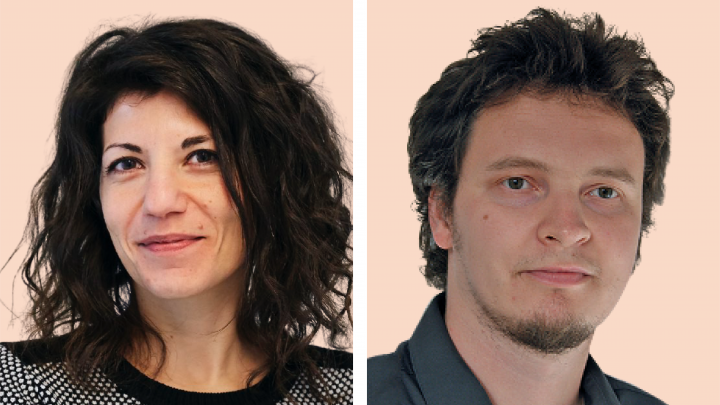
Promotions for Prof. Raffaella Buonsanti and Prof. Bill Morandi
Prof. Raffaella Buonsanti, Core PI at EPFL and Work Package 3 Coordinator at NCCR Catalysis, was recently promoted to Associate Professor, and received an ERC Consolidator Grant. She works on the development of novel synthetic routes to tailor-make multifunctional hybrid materials, based on atomically defined colloidal nanocrystals, and on control of structure and composition at multiple length-scales, driven by a fundamental understanding of the chemical transformations driving nucleation, growth and assembly.
Prof. Bill Morandi, Associate PI at ETH Zurich, was promoted to Full Professor and is Head of the Laboratory of Organic Chemistry. He works on the development of innovative synthetic methodologies for applications across the molecular sciences, with a particular interest in establishing new concepts in catalysis.
Congratulations on these big career steps, Raffaella and Bill!
Prof. Bill Morandi, Associate PI at ETH Zurich, was promoted to Full Professor and is Head of the Laboratory of Organic Chemistry. He works on the development of innovative synthetic methodologies for applications across the molecular sciences, with a particular interest in establishing new concepts in catalysis.
Congratulations on these big career steps, Raffaella and Bill!
16.3.2022
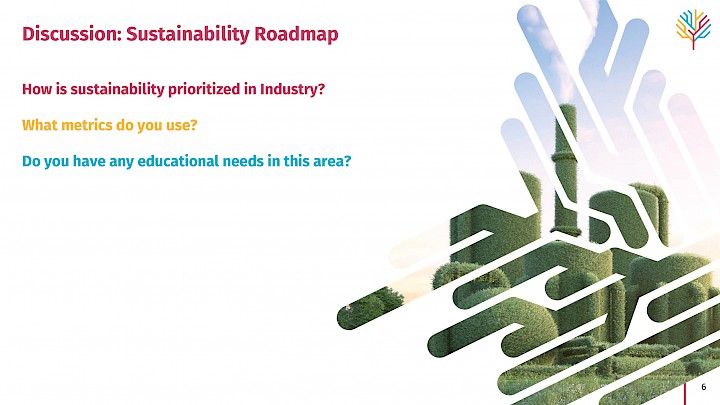
First NCCR Catalysis Industry Panel meeting held
We brought together our Industry Panel for the first time with an online meeting. Here, we could gain industry perspectives from our Panel members, including how they think about sustainability. We thank our Industry Panel for their time and valuable insight!
17.2.2022
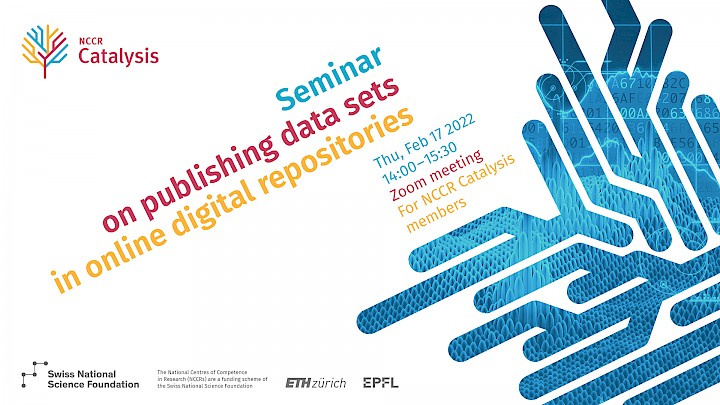
Seminar on publishing data sets in online digital repositories
In this seminar, the NCCR Catalysis Project Office will present the program's strategy for fulfilling SNSF's requirements on data sets and publications. Prof. Nicola Marzari, NCCR Catalysis Associate PI from EPFL, will give an outlook on data accessibility and re-usability, which will be followed by demonstrations on how to upload data sets to the Zenodo and Materials Cloud Archive repositories, and a Q&A session.
This event on February 17 2022 is for NCCR Catalysis members.
This event on February 17 2022 is for NCCR Catalysis members.
15.2.2022

Ajdin Zekjiri joins as Administrative Assistant
Ajdin Zekjiri joined our Project Office as Administrative Assistant in February, and is our team's contact point for administrative matters. He is a part-time student in Linguistic Integration at ZHAW. Welcome to the team, Ajdin!
1.12.2021
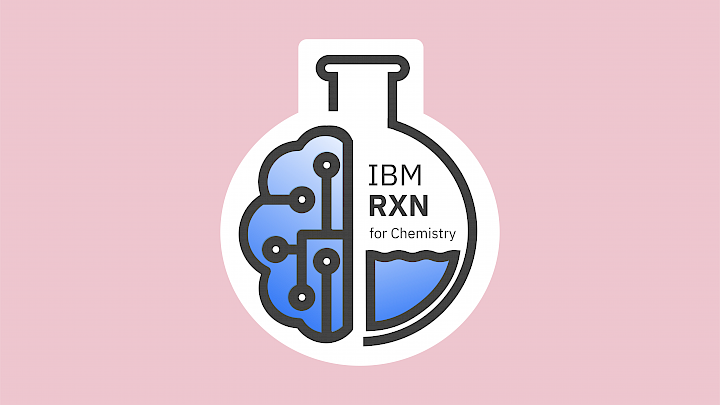
Sandmeyer 2022 Award for the IBM RXN for Chemistry team
The Sandmeyer Award by the Swiss Chemical Society is presented to a team or an individual for outstanding work in the field of industrial or applied chemistry. The IBM RXN for Chemistry Project Team - including NCCR Catalysis members Dr. Alain Vaucher, Dr. Daniel Probst, Dr. Philippe Schwaller, Theophile Gaudin, Alessandra Toniato and Core PI Dr. Teodoro Laino - was awarded the Sandmeyer Award 2022, which recognizes their contributions towards the digitalization of synthetic organic chemistry. Congratulations to all team members!
1.12.2021

Swiss Green & Sustainable Chemistry Award 2022 for Prof. Xile Hu
The Swiss Green & Sustainable Chemistry Award was implemented by the Swiss Chemical Society in collaboration with Syngenta as founding partner and SusChem Switzerland as hosting institution. The award recognizes young academic investigators to contribute to the development of sustainable chemical methodologies and technologies, and targets professors, who have made outstanding scientific discoveries within the field of Green & Sustainable Chemistry. Prof. Xile Hu, Core PI at EPFL, received the Swiss Green & Sustainable Chemistry Award 2022 for his interdisciplinary research to develop catalysis for sustainable synthesis of added-value chemicals and for cost-effective production of solar and electric fuels. Congratulations, Xile!
18.11.2021
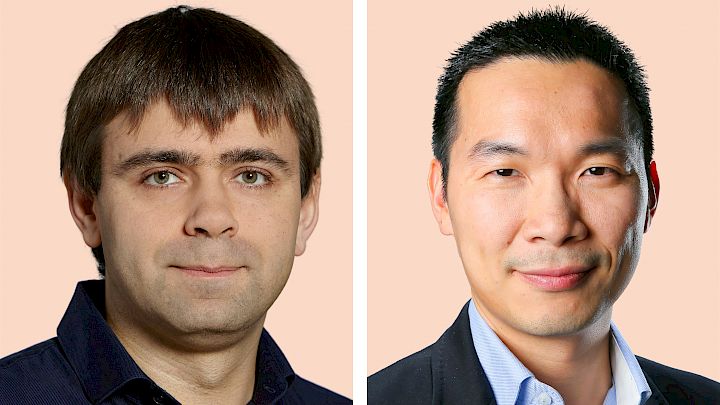
NCCR Catalysis PIs among Clarivate’s 2021 list of Highly Cited Researchers
Prof. Maksym Kovalenko, Core PI at ETH Zurich, and Prof. Xile Hu, Core PI at EPFL, ranked among the top 1% of cited researcher in Clarivate’s 2021 list of Highly Cited Researchers. Congratulations, Maksym and Xile!
15.11.2021
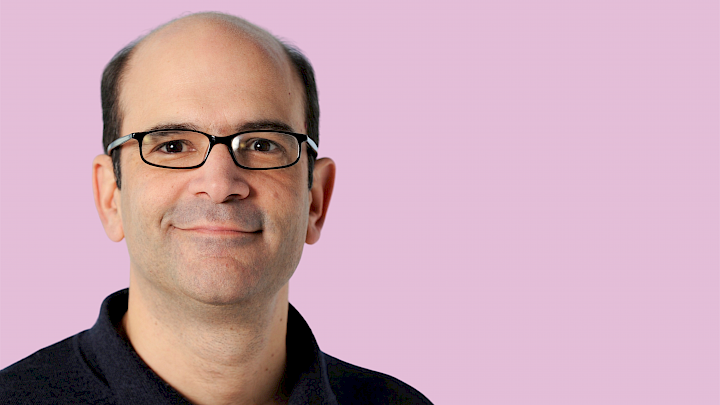
Ryoji Noyori Prize for Prof. Erick M. Carreira
The Ryoji Noyori Prize by Takasago International Corporation and administered by the Society of Synthetic Organic Chemistry, Japan recognizes outstanding contributions to research in asymmetric synthetic chemistry defined in its broadest sense. Prof. Erick M. Carreira, Core PI at ETH Zurich, was awarded the Ryoji Noyori Prize 2021 in recognition of his contributions in various areas, including natural products synthesis, methodology, asymmetric catalysis, medicinal chemistry, and chemical biology. Congratulations, Erick!
19.10.2021
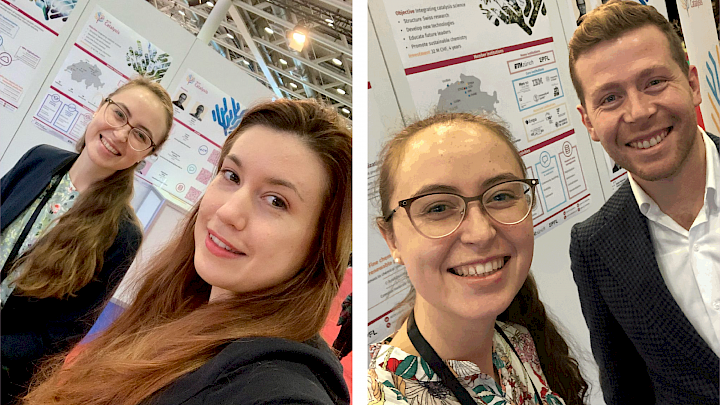
NCCR Catalysis at 2021 ILMAC Forum
Management Team members Lauren Gamp, Dr. Marie Francine Lagadec and Dr. Sebastiaan Huber represented NCCR Catalysis at the 2021 ILMAC Forum, a chemistry, pharmacy and biotechnology platform. We had the pleasure to connect with members of the flow, sustainable and digital chemistry communities, from Switzerland and abroad!
8.10.2021
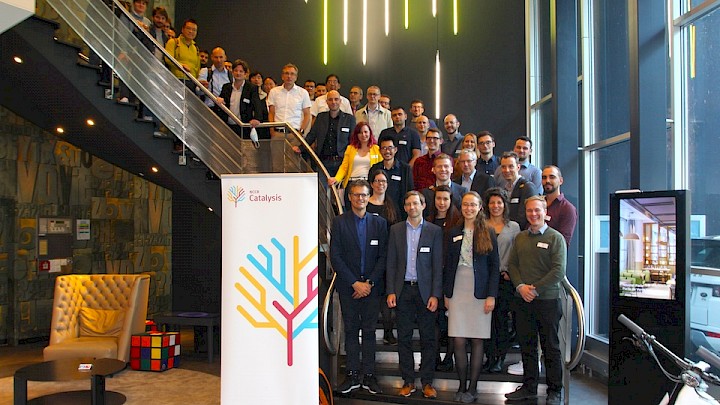
Conclusion of Y1 with evaluation meeting
Our program turned one in August 2021, and we wrapped up the first year with an in-person evaluation meeting in October, held in Bern. We warmly thank all consortium members for their efforts in summarising 77 research projects and the work of more than 200 people. We also thank our review panel, and the SNSF, ETH Zurich and EPFL representatives for the constructive discussions!
28.9.2021

Rössler Prize and Max Planck Fellowship for Prof. Andreas Krause
The Rössler Prize by ETH Zurich is awarded to promising young scientists in the middle of an accelerating career. Prof. Andreas Krause, Core PI at ETH Zurich, was awarded both ETH Zurich’s Rössler Prize recognising him as a rising star in his field of research, and a Max Planck Fellowship for his research in the field of machine learning. As a Max Planck fellow, he will supervise a research group focussing on interactive learning. Congratulations, Andreas!
5.9.2021

Summer School on Catalysis and Sustainable Chemistry
The Swiss Summer School 2021: Catalysis and Sustainable Chemistry is co-organized by the Swiss Chemical Society and NCCR Catalysis, and will take place from September 5-9 2021 in Les Diablerets, Switzerland. The Swiss Summer School 2021 offers an interactive program with input lectures by experts from academia and industry, poster sessions, student presentations, and guest-lectures on topics of general interest. Interested? You can find more information and register here.
27.8.2021
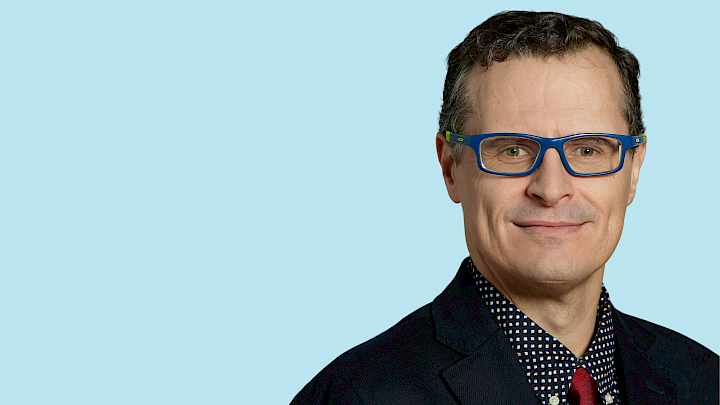
Robert K. Grasselli Award for Prof. Javier Pérez-Ramírez
The 2021 EFCATS Robert K. Grasselli Award for Catalysis honours outstanding theoretical and experimental contributions in the field of oxidation catalysis of the past five years that have advanced our understanding and practice of catalysis. Prof. Javier Pérez-Ramírez, Director of NCCR Catalysis, is the first recipient of this prestigious award. It recognises his discoveries that generated almost unlimited opportunities for innovation in the direct functionalization of natural gas involving halides, and led to better ways to make many key building blocks for the manufacture of chemicals, polymers, and fuels. Congratulations, Javier!
The award ceremony takes place on September 2, 2 PM CEST via the following link: https://s.ntnu.no/EFCATSawards.
The award ceremony takes place on September 2, 2 PM CEST via the following link: https://s.ntnu.no/EFCATSawards.
16.7.2021
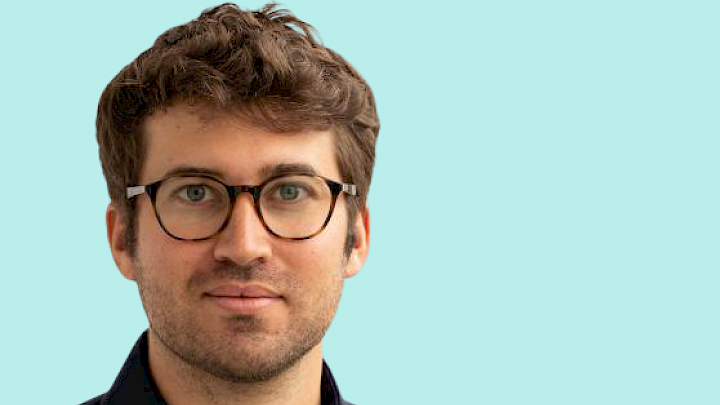
Dr. Philippe Schwaller appointed as Tenure-Track Assistant Professor
Postdoctoral researcher Dr. Philippe Schwaller was appointed as Tenure-Track Assistant Professor at EPFL’s Institute of Chemical Sciences and Engineering, filling one of the three Assistant Professorship positions at ETH Zurich and EPFL that are embedded in NCCR Catalysis. His appointment strengthens our network’s expertise in digital chemistry. Congratulations and welcome as a PI, Philippe!
23.6.2021

Seminar on technology transfer and spin-offs
In this seminar, Dr. Christoph Fik from ETH transfer will overview how and when to valorize research results, and Prof. Wendelin Stark, NCCR Catalysis Core PI from ETH Zurich, will give insights about his vast experience in creating and sustaining spin-offs. Each talk will be followed by a discussion.
This event on June 23 2021 is for NCCR Catalysis members.
This event on June 23 2021 is for NCCR Catalysis members.
17.6.2021

European Inventor Award for Prof. Robert Grass and Prof. Wendelin Stark
With the European Inventor Award, the European Patent Office honours individual inventors and teams of inventors whose pioneering inventions provide answers to some of the biggest challenges of our times. Prof. Robert Grass, adjunct professor at ETH Zurich, and Prof. Wendelin J. Stark, Core PI at ETH Zurich, won the European Inventor Award 2021 for their work on stable data storage in glass-encapsulated DNA. When these beads are applied to products, they ensure that specific indicators - for example origin or working conditions - are traceable throughout the supply chain. Congratulations, Robert and Wendelin!
15.6.2021
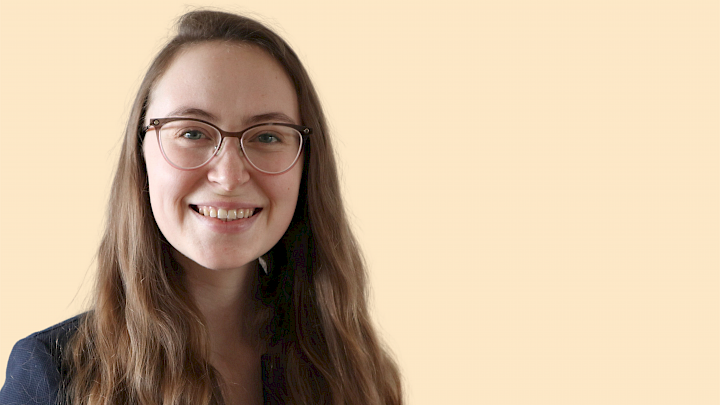
Lauren Gamp joins as Knowledge and Technology Transfer Officer
Lauren Gamp joined our Management Team as Knowledge and Technology Transfer (KTT) Officer in June, and is our program's point of contact for KTT and industry matters. For her master thesis on academia-industry relationships conducted at Hochschule Luzern, Lauren recently won the Swiss Wirtschaftsingenieure award. Welcome to the team and congratulations, Lauren!
14.6.2021
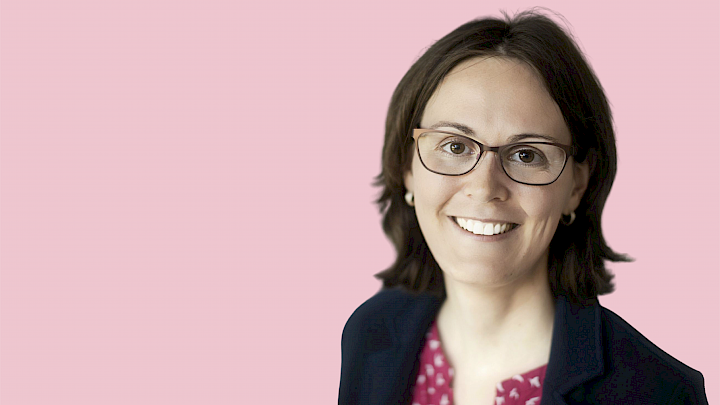
Coblentz Award for Prof. Sandra Luber
The Coblentz Award by the Coblentz Society is presented annually to an outstanding young molecular spectroscopist under the age of 40. Prof. Sandra Luber, Associate PI at UZH where she was promoted to Associate Professor earlier this year, received the Coblentz Award 2021 for her work on molecular spectroscopy. Congratulations, Sandra!
10.6.2021
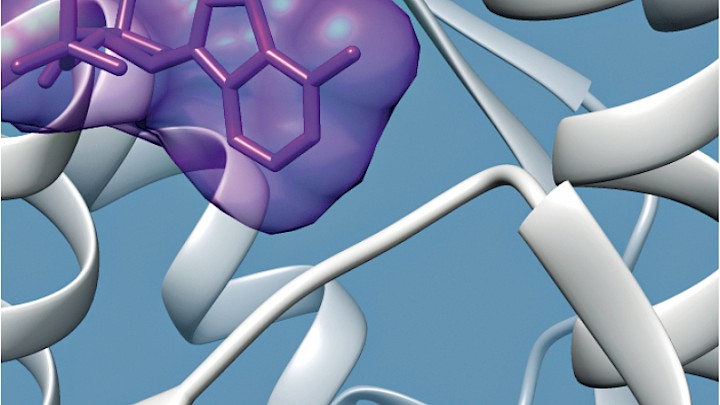
Symposium on industrial biocatalysis
The 12th Wädenswil Day of Life Sciences hosts the 3rd Competence Center of Biocatalysis Symposium on Industrial Biocatalysis on June 10 2021 as a virtual event. The event is organized by ZHAW with Prof. Rebecca Buller - a core member of NCCR Catalysis and Professor at ZHAW - as scientific lead, and with NCCR Catalysis as a partner. In a transdisciplinary environment, this symposium will provide a platform for scientific knowledge transfer and dialog for participants from industry and academia, and bring together renowned researchers to discuss recent advances and future directions of the field. Interested? You can find more information and register here.
7.6.2021
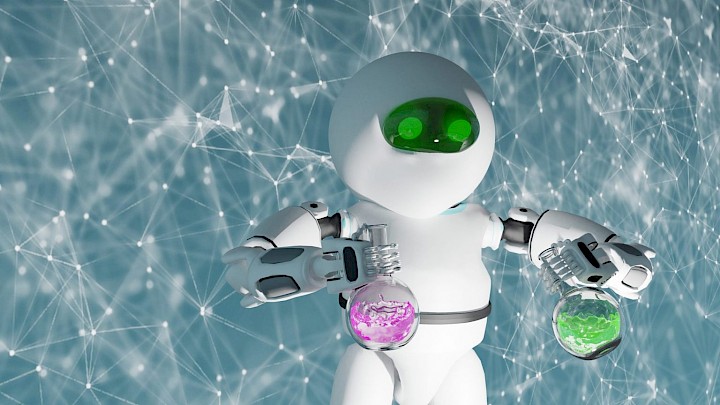
Summer school on big data and machine learning for chemistry
The Summer School on Big Data and Machine Learning for Chemistry is co-organized by EPFL and ETHZ and co-sponsored by NCCR Catalysis, and will take place from June 7-9 2021 as a hybrid live/online event. The summer school will provide an overview on machine learning models through presentations and hands-on tutorials, and discussions on specific applications for computational chemistry, catalysis, and high-throughput screening. The speakers will give both theoretical and experimental perspectives, and the program targets chemists and chemical engineers. Interested? You can find more information and register here.
11.5.2021
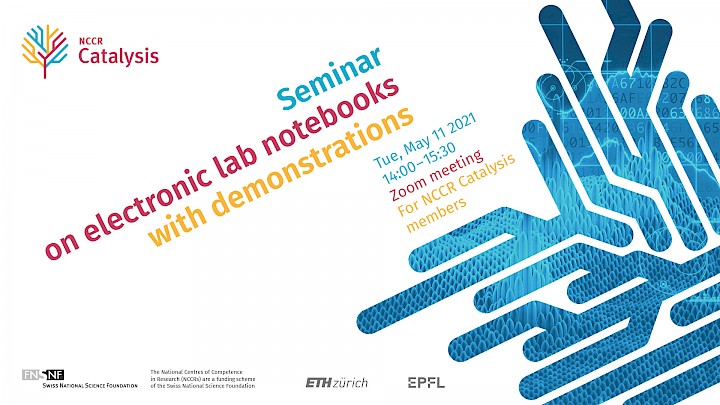
Seminar on electronic lab notebooks with demonstrations
In this seminar, members of NCCR Catalysis will demonstrate a variety of electronic lab notebooks (ELN) they use in their labs, and show how these helps them to be more efficient and produce better science. The different ELNs represent a range of solutions - from free to paid and from being designed for use-cases in chemistry to biology to domain-agnostic. Demonstrations will be given for OpenBIS, Cheminfo, Chemotion, MBook and Jupyter. Developers of some of the ELNs will also be present to answer technical questions from attendees during the discussion.
This event on May 11 2021 is for NCCR Catalysis members.
This event on May 11 2021 is for NCCR Catalysis members.
13.4.2021
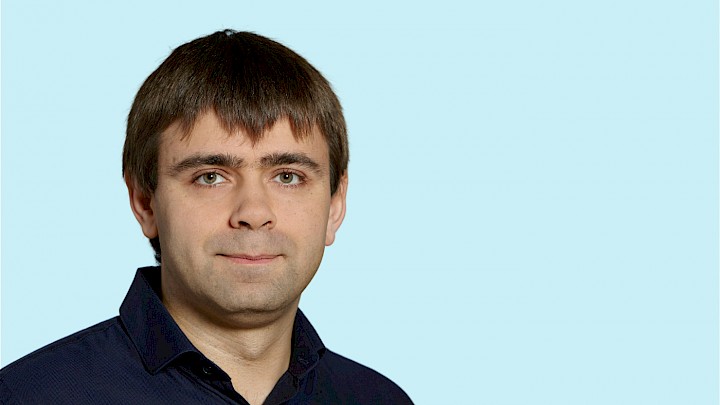
Dan Maydan Prize for Prof. Maksym Kovalenko
The Dan Maydan Prize is awarded yearly to emerging and outstanding young scientists from Israel or abroad for their significant academic accomplishments in the field of nanoscience and nanotechnology. Prof. Maksym Kovalenko, a Core PI of NCCR Catalysis, received the 2021 Dan Maydan Prize for Nanoscience Research for his pioneering work on surface chemistry of nanocrystals and their use for electronic and optoelectronic devices, including batteries, photodetectors, thermo-electrics, solar cells and light sources. Congratulations, Maksym!
25.3.2021
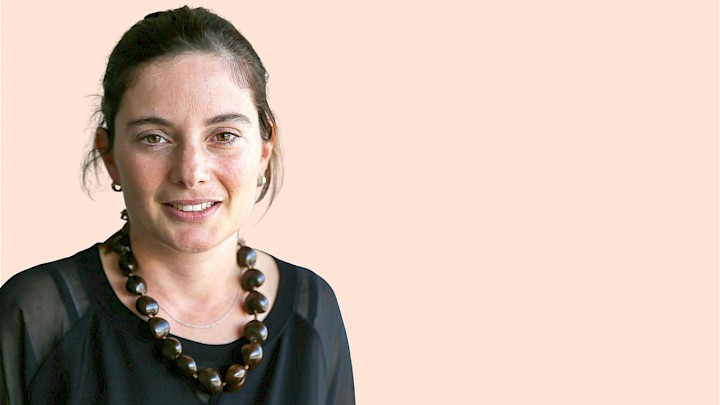
Heilbronner-Hückel Lectureship Award for Prof. Clémence Corminboeuf
The Heilbronner-Hückel Lecture Series is a joint initiative by the Gesellschaft Deutscher Chemiker and the Swiss Chemical Society, and the annual series takes place alternatively in Switzerland and Germany. Prof. Clémence Corminboeuf, Core PI at EPFL, was awarded the Heilbronner-Hückel Lectureship Award 2021 and invited for a lecture tour in Germany. Her work focuses on electronic structure theory in method development, conceptual work applied to homogeneous catalysis and organic electronics and - more recently - models for machine learning. Congratulations, Clémence!
8.3.2021
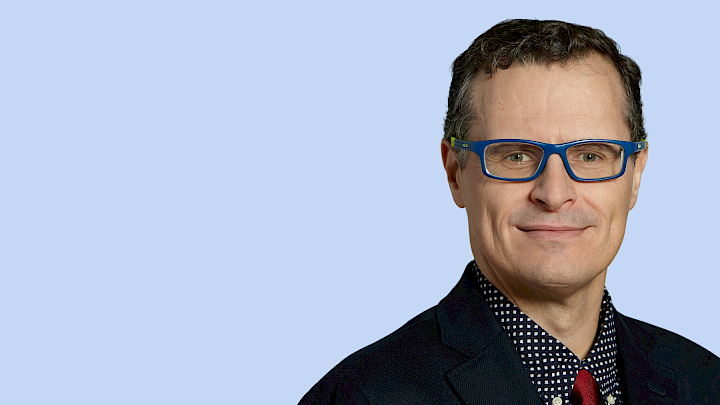
Prof. Javier Pérez-Ramírez at Nature Nano Talks
Nature Nanotechnology will host a virtual panel discussion with panelists from industry and academia. The panel will discuss emerging catalytic materials with industrial-relevant performance, the opportunities and challenges of applying state-of-art nanocatalysts in industry, and the strategies for overcoming challenges and commercializing materials. Tune in to follow the discussion between Nanfeng Zheng from Xiamen University, Kendra Kuhl from Opus-12, Javier Pérez-Ramirez from ETH Zurich and Director of NCCR Catalysis, and Kensaku Kodama from Toyota Central R&D Labs. The panel discussion Nature Nano Talks - Nanocatalysts: a dialogue between academia and industry will take place on Monday, March 8 2021 from 7:00 AM - 8:00 AM CET. Interested? You can sign up here for free.
5.3.2021

Prof. Jeremy Luterbacher now Associate Professor
Prof. Jeremy S. Luterbacher, a Core PI of NCCR Catalysis and previously Tenure Track Assistant Professor at EPFL, was promoted to Associate Professor of Chemical Process Engineering in EPFL's School of Basic Sciences. He works on biomass conversion technologies including alternatives to oil for manufacturing plastics and other common chemicals. He has been awarded a number of prizes for his work in the field of chemical engineering, among them an ACS Sustainable Chemistry & Engineering Lectureship Award. Congratulations, Jeremy!
25.2.2021

Dr. Margaret Faul Award 2021 for Prof. Cristina Nevado
The Dr. Margaret Faul Award for Women in Chemistry is awarded to young woman within the first 15 years of their independent career in chemical research in recognition of their outstanding achievements in organic chemistry. Prof. Cristina Nevado, a Core PI of NCCR Catalysis, was awarded the Dr. Margaret Faul Award 2021 for the breadth and diversity of her work - spanning the development of new catalytic methods, important contributions in the synthesis of medicinally relevant natural products, and development of bioactive chemical probes. Congratulations, Cristina!
5.2.2021

Prof. Thomas Ward awarded 2021 ACS Catalysis Lectureship
The ACS Catalysis Lectureship for the Advancement of Catalytic Science is awarded to an individual or team in recognition of their ground-breaking research in catalysis over the past seven years, and is cosponsored by the ACS Division of Catalysis Science and Technology (CATL) and ACS Catalysis. Prof. Thomas R. Ward, a Core PI of NCCR Catalysis, was awarded the 2021 ACS Catalysis Lectureship for his cross-disciplinary research approach on artificial metalloenzymes for organic synthesis - by merging organometallic catalysis with enzymatic catalysis - in living systems, which blurrs boundaries across fields of catalysis. Congratulations, Tom!
14.1.2021
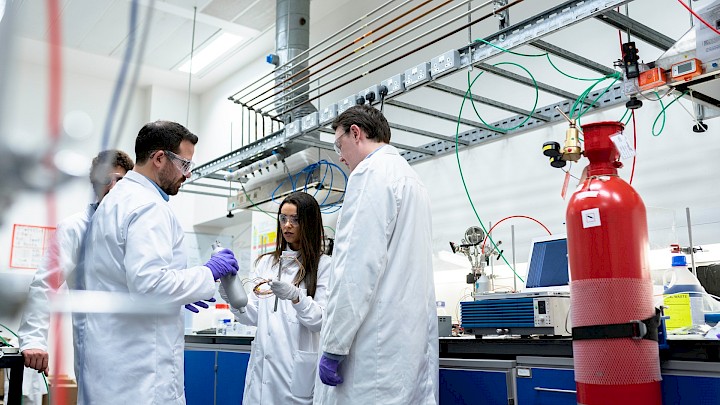
NCCR Catalysis at NCCR MARVEL Sector Day 2021
The NCCR Catalysis was invited to attend the virtual NCCR MARVEL Sector Day 2021 on Chemistry and Catalysis, and given the opportunity to present our community to the NCCR MARVEL and to industry representatives. Thank you for inviting us, NCCR MARVEL, and for the great discussions with the participants!
17.12.2020

Prof. Raffaella Buonsanti awarded Werner Prize 2021
The Werner Prize by the Swiss Chemical Society is awarded to promising young scientists for outstanding independent chemical research. Prof. Raffaella Buonsanti, a Core PI and work package coordinator of NCCR Catalysis, was awarded the Werner Prize 2021 for her original and significant contributions in the chemistry development of tailored nanomaterials and their applications in catalysis, especially CO₂ electroreduction. Congratulations, Raffaella!
15.10.2020
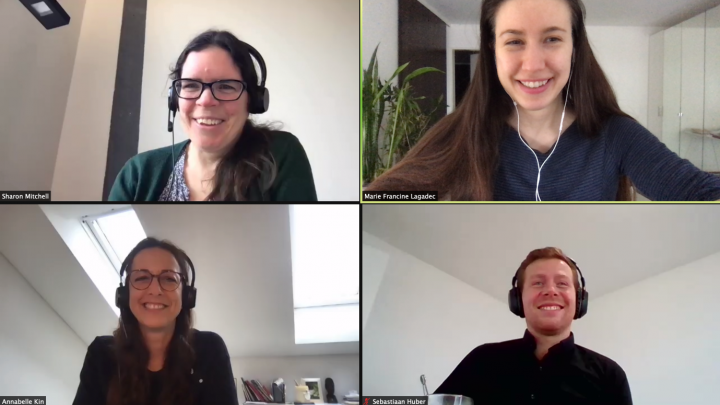
Project Office is operative
The NCCR Catalysis Project Office is now operative. It consists of Dr. Marie Francine Lagadec (Program Coordinator, ETHZ), Dr. Sharon Mitchell (Program Advisor, ETHZ), Annabelle Kin (Administrative and Finance Officer, ETHZ), and Dr. Sebastiaan Huber (Data Officer, EPFL).
1.8.2020
Launch of NCCR Catalysis
We're delighted to announce the launch of the NCCR Catalysis, which is funded by the Swiss National Science Foundation, and hosted by ETHZ and EPFL. In the coming years, we will investigate new approaches to create carbon-neutral chemical value chains based on catalytic processes. At the contributing institutions - ETHZ, EPFL, HES-SO, IBM, UniBas, UniBe, UZH, ZHAW - more than 100 scientists are working towards shaping a digital-driven accelerated shift to develop future catalytic technologies, and to enable a renewable society with carbon-neutral chemical value chains.